Domaine Éric Forest (Biodynamic)

The Estate
The Forest family has been making wine in the Maconnais region for 8 generations. However, André (Eric Forest’s grandfather), was the first of his family to dedicate himself to producing wine exclusively, and it was through him that Eric learned about winemaking and biodynamics. Eric also studied enology and worked in the Yakima Valley in 1996, as well as working two years with Jean-Marie Guffens. In 1999, Eric took over management of the estate and eventually expanded the size of the domaine to 8.9 hectares.
Eric cultivates vines on some of the finest terroirs in Vergisson, as well as a plot on the heights of Davayé. He produces five exclusive vintages of Pouilly-Fuissé, Saint-Véran, and Macon-Vergisson on plots of vines planted between 1930 and 1979. Everything is manually done on the estate, and he uses organic and biodynamic methods in the vineyards, but is not certified. The plants are pruned in a manner to allow for the vines to have ample ventilation, thus minimizing the need to use phytosanitary products. Eric combats any other plant species with an environmental approach by carrying out extra plowing to sustain the soil and to encourage the roots to absorb the rich qualities held within the terroir.
The winemaking process begins with a manual harvest followed by very gentle pressing. The wine stands on its lees for 10-15 months inside oak barrels with reduced doses of sulfites. The wine is then bottled by hand using gravity and often unfiltered. As a passionate winemaker, Eric brings the utmost care and attention to all stages of the winemaking process, a personal commitment to deliver the high standards representative of his terroir.
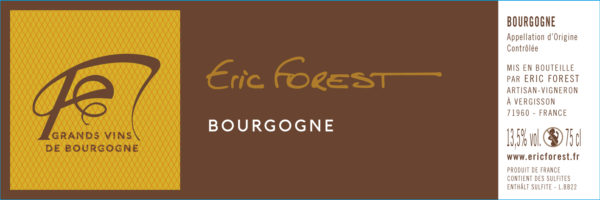
Bourgogne Blanc
Location: The Bourgogne Blanc is produced from a 0.20-hectare plot of vines planted in 2017 in Vergisson on the edge of the Pouilly-Fuissé appellation.
Terroir: The terroir begins at the bottom with beautiful blue marls and ends at the top with decomposed granite. The microclimate and the rather cool exposure, as well as the youth of the vines make a wine which lacks a little richness and structure. This is why Forest blends his Pouilly-Fuissé end-of-press wines, which have more volume and higher pH, with this vintage.
Grape Variety: Chardonnay
Vinification: 50% vinified in barrels and 50% in vats to maintain freshness and finesse.
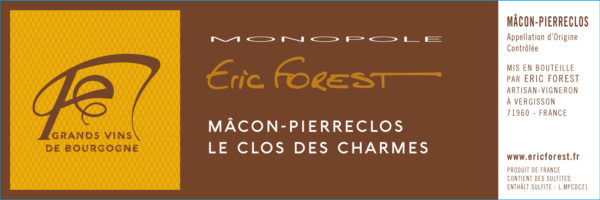
Mâcon-Pierreclos Monopole Le Clos Des Charmes
Overview: This 1.5-hectare geological unit of which Forest has the Monopole is planted with Chardonnay and produces very great, rich, and vibrant wines.
Average Age of the Vines: Almost a century old for the most part.
Exposure: South
Soil: Clay and colored marl on the outcropping limestone rock.
Grape Variety: Chardonnay
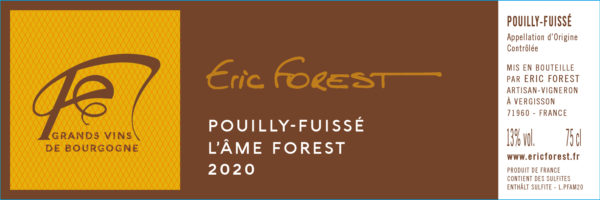
Pouilly-Fuissé L'Ame Forest
Terroir: l’Âme Forest is a blend of four cooler terroirs: the marls of “La Côte” give powerful, mineral structure as well as length on the finish, while the clay-limestone of the “Tilliers” and “Le Bois Rosier” bring finesse with notes of citrus and stone fruit. As for the old Carmentrants vines, they add richness and depth. The soul of this cuvée is born from a perfect balance of these plots planted by André (Eric’s grandfather), cultivated by Michel (his father), and taken over by Eric in 1999.
Vinification: The grapes are pressed very gently and over long periods of time, without crushing, and then fermented in cask on native yeast with much of the lees.
Aging: The wine is matured over two winters before bottling without filtration and with very little sulfur.
Tasting Notes: Born from the coolest areas of Vergisson, l’Ame Forest is a great way to discover the estate’s style. It is balanced, intense in energy, and very fresh on the palate.
Alcohol: 13%
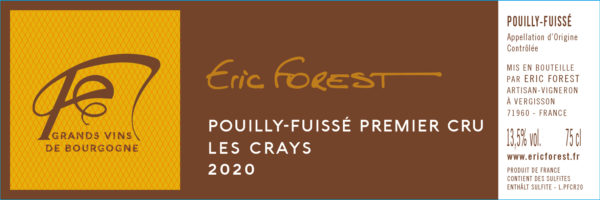
Pouilly-Fuissé 1er Cru Les Crays
Terroir: “Les Crays” is a terroir of limestone scree on blue Pliensbachian marl. This south-facing slope of the Vergisson rock, very bright and protected from the cool north wind, produces fatty wines with chiseled minerality and rich citrus aromas.
Production Area: 2.16 hectares
Age of the Vines: This cuvée is harvested from several plots planted between 1930 and 1966.
Vinification: The grapes are pressed very gently and over long periods of time, without crushing, and then fermented in cask on native yeast with much of the lees.
Aging: The wine is matured over two winters before bottling without filtration and with very little sulfur.
Alcohol: 13.5%
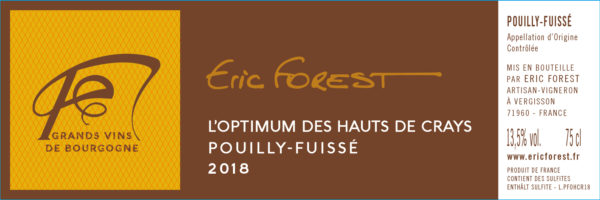
Pouilly-Fuissé L'Optimum Des Hauts De Crays
First Planting: 1930s
Grape Variety: Chardonnay
Harvest: End of September
Vinification: Fermented in fût and amphora
Alcohol: 15.42%
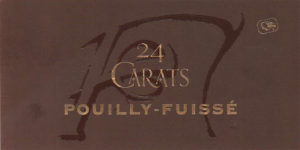
Pouilly-Fuissé 24 Carats
Notes: This micro cuvée is a blend of the best 3 or 4 barrels from Forest’s cellar. It is not produced for every vintage.
Location: Forest lovingly extract this cuvee from the most beautiful terroirs in Vergisson. 1/3 from La Roche plot and 2/3 from Les Crays plot.
Grape Variety: Chardonnay
Alcohol: 13.5%
Tasting Notes: 99.9% pure, this cuvee harmoniously reflects the power of the clay, the brilliance of the limestone, and the voluptuousness of Chardonnay.
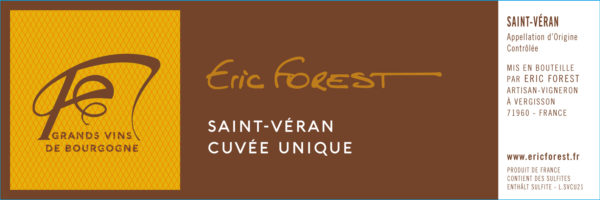
Saint-Véran Cuvée Unique
Overview: The severe frosts of April 2021 destroyed the majority of the vine buds. The very small harvest led Eric Forest to blend his two different plots of Saint-Véran to produce an exceptional Saint-Véran “Cuvée Unique”.
Appellation: Saint-Véran
Grape Variety: Chardonnay
Alcohol: 13%
Plots: Cuvée Unique is produced from 2 separate Saint-Véran plots:
Terre Noire –
Surface Area: 0.5 hectares in the town of Davayé
Average Age of the Vines: 80 years old. These old vines produce very small, thick-skinned grapes which give character and density to the wine.
Terroir: Terre Noire is a very great terroir for Chardonnay. Slightly sloping facing south, it is composed of 60-80 cm of brown clay on the surface on a very stony subsoil of white limestone with “entroque” or marine fossils.
La Côte Rôtie –
Surface Area: 0.5 hectares in the town of Davayé
Average Age of the Vines: Planted in 1979, over 40 years old.
Terroir: “La Côte Rôtie” is the name registered in the 19th century of a very steep limestone hillside facing south at the bottom of the valley. It is a sun-burnt oven where Forest harvests very ripe Chardonnay. The wines from this microclimate are very rich and bold with a “gastronomic” power.
Yield: 9 hl/ha
Harvest: Manual harvest into 50 kg boxes
Vinification: Soft and slow pressing, in bunches crushed by gravity. Vinification with natural yeasts in 3 barrels of 300 liters.
Aging: 12 months in barrels without racking and without stirring. Bottling by gravity without filtration or fining.
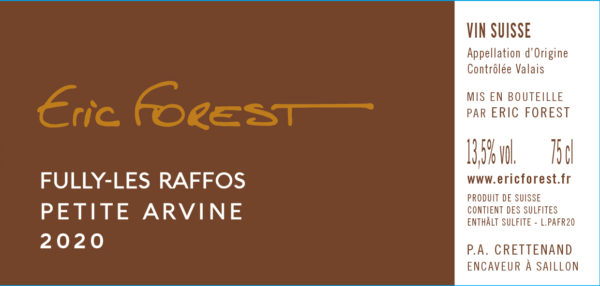
Petite Arvine Fully-Les Raffos
Overview: For his 20th vintage, Eric Forest had the opportunity to bring an old dream to reality: to create an ultra-confidential and absolutely superb Petite Arvine which comes from the most famous terroir in Valais Switzerland, Fully. To understand the origin of this passion for Petite Arvine, one has to go back in time – Eric’s father used to fill the family wine cellar with beautiful Swiss bottles selected by friends from Valais, where the Forest family often went on vacation. From adolescence, Eric familiarized himself with these whites, dry and sweet, and learned to love them for their complexity and many nuances.
In 2017, while on a tour with a Swiss importer, Eric met Pierre-Antoine Crettemand (meticulous winegrower in Saillon and owner of vines in Fully) whose family has been making wine for generations. Eric did not hesitate long before deciding to take the plunge and come to make wine by his side.
The Vines: The Fully Les Raffos is produced from old massal selections of Petite Arvine grown organically by Pierre-Antoine. The latter of course brings his intimate knowledge of the terroir and the vine, while Eric brings to the steep slopes of Fully a Burgundian spirit that is clearly found in the wine.
Vinification: Eric selects the optimal harvest date for the grapes. The vinification process starts with the extreme precision of Eric’s fractional pressings, for which he retains here only the press media, the purest juices that he vinifies without débourbage.
Aging: Eric follows the fermentation and aging by phone and goes to the winery himself every 3 months. The wine is aged in a small wine cave dug into the rock just below the Chateau de Fully. He uses the barrels of his Pouilly-Fuissé Les Crays which he brings from Vergisson, barrels already inoculated with the indigenous yeasts of Vergisson. After a year in barrels, the aging is extended for another 6 months on fine lees in stainless steel vats. Finally he carries out the bottling by gravity without filtration or fining.
Tasting Notes: The Petite Arvine Fully-Les Raffos is masterful in its refinement and balance. It is airy on the nose; one perceives notes of wildflowers and wild mountain herbs. Allowed to breathe, the sensual dimension of the wine asserts itself, with intertwined notes of grape jelly, poached peach or pear, and baked apple, suffused with many spices with Asian accents, between cumin, candied ginger, nutmeg and incense. On the palate, it is both generous, textured, and perfectly defined. Notes of pineapple, caramelized pear, and marmelade, enhanced by a touch of pepper. Fine bitterness reminiscent of green pepper, picholine olive, and cardamom tickle the taste buds on the finish. A full and expressive finish, with good length.
Alcohol: 13.5%
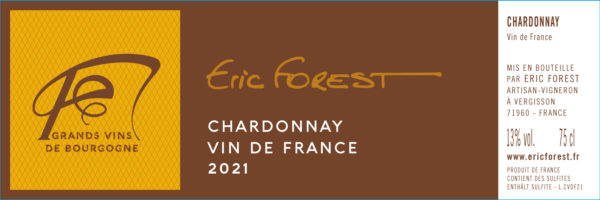
Chardonnay
Appellation: Vin de France
Location: Vines planted in Limoux
Alcohol: 13%
Domaine Gérard Peirazeau et Fils
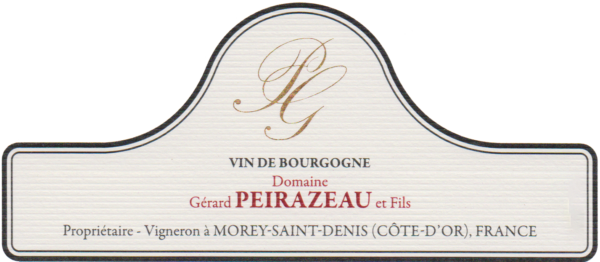
The Estate
Jules Groffier (1898-1974) acquired the first vineyard holdings of the domaine, which were later divided between his children: Robert Groffier and Bernadette Groffier. Bernadette married into the Peirazeau family and established “Domaine Peirazeau-Groffier.” Laurent Peirazeau, grandson of Bernadette and son of Gérard, decided to expand the family’s production from the 2019 vintage onward under the label “Gérard Peirazeau & Fils”.
Laurent, along with his partner Sophie Charlopin, who comes from a prominent wine family herself, manages a 3.65-hectare vineyard spread across 3 villages, including Morey St Denis, Chambolle-Musigny, and Gevrey-Chambertin. Although the vineyard is relatively small, it boasts exceptional terroirs and plot locations. The domain produces 13 appellations, 5 of which are among the most celebrated Grand Crus, including Chambertin Clos de Bèze, Charmes Chambertin, Clos de la Roche, Clos Saint-Denis, and Bonnes Mares. The majority of the vineyards consist of old vines, with an average age of 60 years.
The domaine practices sustainable cultivation using organic or biocontrol products, but is not certified. Plowing is limited, and weeding is rare.
In the cellar, Peirazeau does not use any added products; only native yeasts are used for fermentation. The red wines, except Coteaux Bourguignons and Bourgogne Pinot Noir, are all aged in oak barrels.
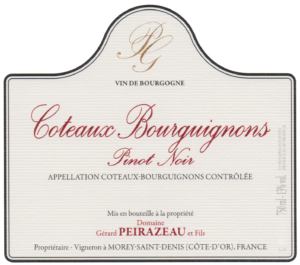
Coteaux Bourguignons Pinot Noir
Appellation: Coteaux Bourguignons
Grape Variety: Pinot Noir
Viticulture: The vineyard is cultivated using sustainable methods. Peirazeau uses organic products as much as possible and no pesticides. He shows respect for the subsoil with rigorous mechanical work by limiting passages in order to avoid compaction as much as possible.
Vinification: The harvest is entirely destemmed, to avoid excess tannins. In the cellar, Peirazeau has a minimal-intervention approach; he uses only indigenous yeasts and no added substances. The grapes are macerated in stainless steel tanks for 2-4 weeks with gentle manual pumping-over and punching-down for soft extraction.
Aging: In stainless steel tank.
Tasting Notes: Aromas of raspberries, cherries, and black pepper delight the palate. The tannins and acidity are well balanced, making it easy to drink.
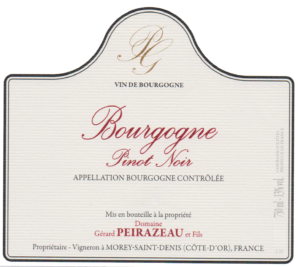
Bourgogne Pinot Noir
Vineyard Plot: The original plot was classified as a village appellation, but due to a revision of the land use plan the plot was downgraded.
Grape Variety: Pinot Noir
Viticulture: The vineyard is cultivated using sustainable methods. Peirazeau uses organic products as much as possible and no pesticides. He shows respect for the subsoil with rigorous mechanical work by limiting passages in order to avoid compaction as much as possible.
Vinification: The harvest is entirely destemmed, to avoid excess tannins. In the cellar, Peirazeau has a minimal-intervention approach; he uses only indigenous yeasts and no added substances. The grapes are macerated in stainless steel tanks for 2-4 weeks with gentle manual pumping-over and punching-down for soft extraction.
Aging: In stainless steel tank.
Tasting Notes: Classic. The Bourgogne Pinot Noir is marked by its vegetal nose. During its vinification, extractions are limited to guarantee freshness, roundness, and suppleness.
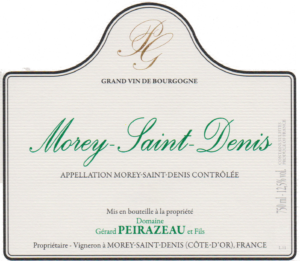
Morey-Saint-Denis Blanc
Grape Variety: Chardonnay
Viticulture: The vineyard is cultivated using sustainable methods. Peirazeau uses organic products as much as possible and no pesticides. He shows respect for the subsoil with rigorous mechanical work by limiting passages in order to avoid compaction as much as possible.
Vinification: The harvest is entirely destemmed, to avoid excess tannins. In the cellar, Peirazeau has a minimal-intervention approach; he uses only indigenous yeasts and no added substances. The grapes are macerated in stainless steel tanks for 2-4 weeks with gentle manual pumping-over and punching-down for soft extraction.
Aging: In oak barrels (around 30% new oak on average) for about 18 months, no racking. Light filtration before bottling.
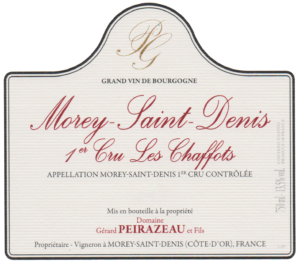
Morey-Saint-Denis 1er Cru Les Chaffots
Vineyard Plot: The plot is located above Clos Saint-Denis with very stony soil and a pronounced slope.
Grape Variety: Pinot Noir
Viticulture: The vineyard is cultivated using sustainable methods. Peirazeau uses organic products as much as possible and no pesticides. He shows respect for the subsoil with rigorous mechanical work by limiting passages in order to avoid compaction as much as possible.
Vinification: The harvest is entirely destemmed, to avoid excess tannins. In the cellar, Peirazeau has a minimal-intervention approach; he uses only indigenous yeasts and no added substances. The grapes are macerated in stainless steel tanks for 2-4 weeks with gentle manual pumping-over and punching-down for soft extraction.
Aging: In oak barrels (around 30% new oak on average) for about 18 months, no racking. Light filtration before bottling.
Tasting Notes: The feminine Morey-Saint-Denis les Chaffots is similar in style to Chambolle-Musigny. Velvety, fatty, supple, and airy are its characteristics.
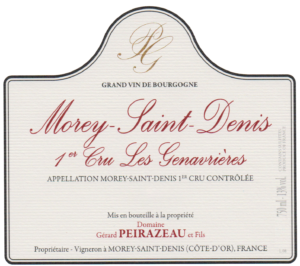
Morey-Saint-Denis 1er Cru Les Genavriéres
Vineyard Plot: Situated above Clos de la Roche and very close to Chambertin.
Grape Variety: Pinot Noir
Viticulture: The vineyard is cultivated using sustainable methods. Peirazeau uses organic products as much as possible and no pesticides. He shows respect for the subsoil with rigorous mechanical work by limiting passages in order to avoid compaction as much as possible.
Vinification: The harvest is entirely destemmed, to avoid excess tannins. In the cellar, Peirazeau has a minimal-intervention approach; he uses only indigenous yeasts and no added substances. The grapes are macerated in stainless steel tanks for 2-4 weeks with gentle manual pumping-over and punching-down for soft extraction.
Aging: In oak barrels (around 30% new oak on average) for about 18 months, no racking. Light filtration before bottling.
Tasting Notes: This Morey-Saint-Denis 1er Cru Les Genavrières evokes aromas of black cherry and cooked plum with spicy and lively touches. The palate is silky, tasty and lively. Its finish is powerful and elegant.
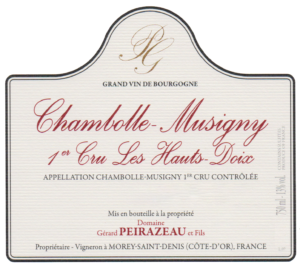
Chambolle-Musigny 1er Cru Les Hauts-Doix
Vineyard Plot: Situated between Les Charmes & Les Amoureuses.
Soil: Stony soil and a marl subsoil
Grape Variety: Pinot Noir
Average Age of the Vines: 70 years old for half of the vines, and 100 years old for the other half.
Viticulture: The vineyard is cultivated using sustainable methods. Peirazeau uses organic products as much as possible and no pesticides. He shows respect for the subsoil with rigorous mechanical work by limiting passages in order to avoid compaction as much as possible.
Vinification: The harvest is entirely destemmed, to avoid excess tannins. In the cellar, Peirazeau has a minimal-intervention approach; he uses only indigenous yeasts and no added substances. The grapes are macerated in stainless steel tanks for 2-4 weeks with gentle manual pumping-over and punching-down for soft extraction.
Aging: In oak barrels (around 30% new oak on average) for about 18 months, no racking. Light filtration before bottling.
Tasting Notes: The soil brings elegance and power controlled by a good roundness.
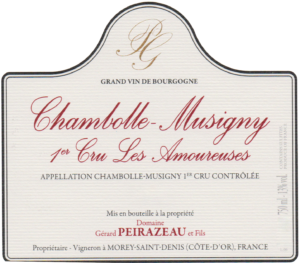
Chambolle-Musigny 1er Cru Les Amoureuses
Vineyard Plot: 0.21-hectare holding. Often considered as Grand Cru.
Grape Variety: Pinot Noir
Average Age of the Vines: Up to 80 years old.
Viticulture: The vineyard is cultivated using sustainable methods. Peirazeau uses organic products as much as possible and no pesticides. He shows respect for the subsoil with rigorous mechanical work by limiting passages in order to avoid compaction as much as possible.
Vinification: The harvest is entirely destemmed, to avoid excess tannins. In the cellar, Peirazeau has a minimal-intervention approach; he uses only indigenous yeasts and no added substances. The grapes are macerated in stainless steel tanks for 2-4 weeks with gentle manual pumping-over and punching-down for soft extraction.
Aging: In oak barrels (around 30% new oak on average) for about 18 months, no racking. Light filtration before bottling.
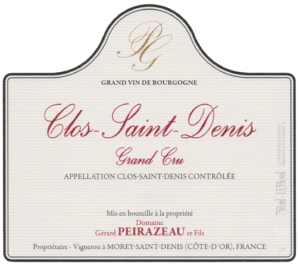
Clos Saint-Denis Grand Cru
Soil: Clay limestone and marl.
Grape Variety: Pinot Noir
Viticulture: The vineyard is cultivated using sustainable methods. Peirazeau uses organic products as much as possible and no pesticides. He shows respect for the subsoil with rigorous mechanical work by limiting passages in order to avoid compaction as much as possible.
Vinification: The harvest is entirely destemmed, to avoid excess tannins. In the cellar, Peirazeau has a minimal-intervention approach; he uses only indigenous yeasts and no added substances. The grapes are macerated in stainless steel tanks for 2-4 weeks with gentle manual pumping-over and punching-down for soft extraction.
Aging: In oak barrels (around 30% new oak on average) for about 18 months, no racking. Light filtration before bottling.
Tasting Notes: Voluptuous and gorgeous fragrance. This wine is open, elegant, and the height of sophistication.
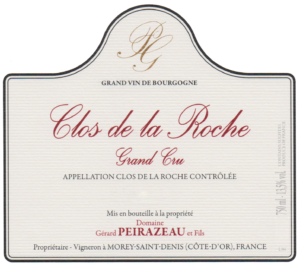
Clos de la Roche Grand Cru
Vineyard Plot: 0.40-hectare holding.
Grape Variety: Pinot Noir
Viticulture: The vineyard is cultivated using sustainable methods. Peirazeau uses organic products as much as possible and no pesticides. He shows respect for the subsoil with rigorous mechanical work by limiting passages in order to avoid compaction as much as possible.
Harvest: The vines are old, and the grapes are therefore millerandé. They are harvested very ripe while retaining their acidity, guaranteeing a high quality balance.
Vinification: The harvest is entirely destemmed, to avoid excess tannins. In the cellar, Peirazeau has a minimal-intervention approach; he uses only indigenous yeasts and no added substances. The grapes are macerated in stainless steel tanks for 2-4 weeks with gentle manual pumping-over and punching-down for soft extraction.
Aging: In oak barrels (around 30% new oak on average) for about 18 months, no racking. Light filtration before bottling.
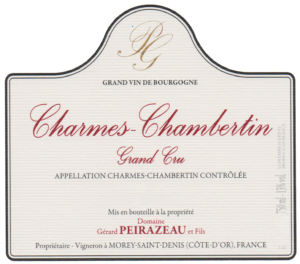
Charmes-Chambertin Grand Cru
Vineyard Plot: 0.22-hectare holding.
Soil: Limestone, with a subsoil that contains a layer of thick marl.
Grape Variety: Pinot Noir
Average Age of the Vines: Up to 80 years old.
Viticulture: The vineyard is cultivated using sustainable methods. Peirazeau uses organic products as much as possible and no pesticides. He shows respect for the subsoil with rigorous mechanical work by limiting passages in order to avoid compaction as much as possible.
Vinification: The harvest is entirely destemmed, to avoid excess tannins. In the cellar, Peirazeau has a minimal-intervention approach; he uses only indigenous yeasts and no added substances. The grapes are macerated in stainless steel tanks for 2-4 weeks with gentle manual pumping-over and punching-down for soft extraction.
Aging: In oak barrels (around 30% new oak on average) for about 18 months, no racking. Light filtration before bottling.
Tasting Notes: The soil is gives vigor to this wine which can be described as virile, but also a persistence of roundness.
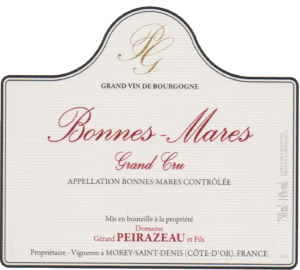
Bonnes Mares Grand Cru
Vineyard Plot: Bonnes-Mares straddles Morey-Saint-Denis and Chambolle-Musigny.
Grape Variety: Pinot Noir
Viticulture: The vineyard is cultivated using sustainable methods. Peirazeau uses organic products as much as possible and no pesticides. He shows respect for the subsoil with rigorous mechanical work by limiting passages in order to avoid compaction as much as possible.
Vinification: The harvest is entirely destemmed, to avoid excess tannins. In the cellar, Peirazeau has a minimal-intervention approach; he uses only indigenous yeasts and no added substances. The grapes are macerated in stainless steel tanks for 2-4 weeks with gentle manual pumping-over and punching-down for soft extraction.
Aging: In oak barrels (around 30% new oak on average) for about 18 months, no racking. Light filtration before bottling.
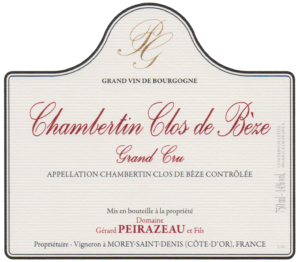
Chambertin-Clos de Bèze Grand Cru
Grape Variety: Pinot Noir
Average Age of the Vines: Up to 80 years old.
Viticulture: The vineyard is cultivated using sustainable methods. Peirazeau uses organic products as much as possible and no pesticides. He shows respect for the subsoil with rigorous mechanical work by limiting passages in order to avoid compaction as much as possible.
Vinification: The harvest is entirely destemmed, to avoid excess tannins. In the cellar, Peirazeau has a minimal-intervention approach; he uses only indigenous yeasts and no added substances. The grapes are macerated in stainless steel tanks for 2-4 weeks with gentle manual pumping-over and punching-down for soft extraction.
Aging: In oak barrels (around 30% new oak on average) for about 18 months, no racking. Light filtration before bottling.
Domaine Gracieux Chevalier
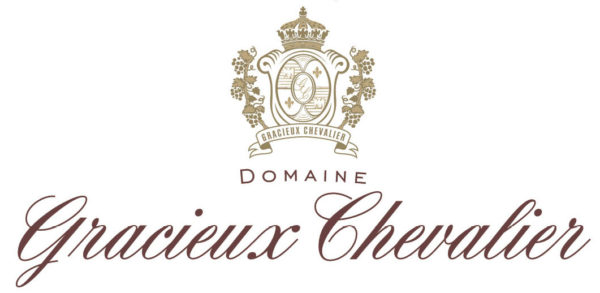
Overview
The estate of Veuve Ambal encompasses 250 hectares of vines, making it one of the largest owners of vineyards in Burgundy.
All of the Veuve Ambal domaines, including Domaine Gracieux Chevalier, are managed using sustainable agriculture. The use of specific cultivation techniques reduces the use of chemical treatments by optimizing their position and efficiency. Concern for the environment is at the core of the company’s ethos, from the vineyards right up to the vinification process.
The domaines are located in 6 different terroirs. This diversity brings richness and aromatic complexity to the wines produced. The Crémant de Bourgogne by Veuve Ambal draws on the unique characteristics of each Burgundian terroir.
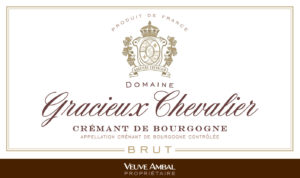
Crémant de Bourgogne
Location: Gracieux Chevalier is located in the southern half of the Chablis region and covers 56 hectares of vineyards, 45 of which are adjoining. Planted with low-trained vines in Kimmeridgian and Portlandian soils, the Crémant de Bourgogne is produced on the ancient Pérignon farm in Cravant.
Varietal Blend: Pinot Noir (39ha), Chardonnay (12ha), Aligoté (5ha)
Vinification: The Cuvée Domaine Gracieux Chevalier is blended with 20-25% reserve wines. The wine is aged on racks for 20-35 months in order to impart aromatic intensity.
Tasting Notes: Golden color with vivacious bubbles. Warm notes of freshly-baked pastries and fleshy fruits such as apricot, peach, cherry, and blackberry. The Chardonnay grapes bring the minerality and notes of white flowers that characterize a high quality Crémant de Bourgogne; a complex yet surprising blend.
Food Pairings: Delicious when paired with smoked charcuterie as an aperitif, or as a complement to rare roast beef.
Cellaring Potential: To be consumed young or within 3 years of bottling
Serving Temperature: 7-8°C
Domaine Hubert Bouzereau-Gruère & Filles – Côte de Beaune
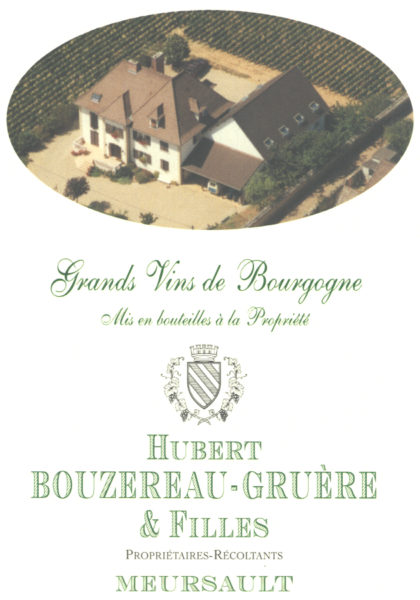
The Estate
Domaine Hubert Bouzereau Gruère is a family business, named for the union of two old winemaking families: Hubert Bouzereau in Meursault, and Marie-France Gruère in Chassagne-Montrachet.
Hubert Bouzereau is the 7th generation of winemakers of his family and it was in 1970 that he established his own estate with his wife Marie-France.
Today, two of their daughters have joined them in the family business: Marie-Laure has been working at the Domaine since 1995 and Marie-Anne since 1999.
In 2001, the daughters partnered with their father and created Domaine Hubert Bouzereau Gruère et Filles. Marie-Laure and Marie-Anne represent the 8th generation of the winemaking family. They are at the head of a 10-hectare estate spread out over 6 communes in the Côte de Beaune, the production of which is three quarters white wine and one quarter red. The Domaine is quite varied and is composed of Grand Cru, Premiers Crus, Villages, and Regional appellations.
Marie-Laure is in charge of administrative duties and marketing, as well as hospitality. Marie-Anne is responsible for vinification, order preparation, receiving clients, and some aspects of marketing. In addition, both women work an equal amount of time in the vineyards.
Hubert is a passionate winemaker, and has transferred his love for and knowledge of the craft of winemaking to his daughters. To this day, he continues to work with great pleasure and care among his vines and in the cellars.
The wines of the Domaine are regularly cited in wine guides such as Guide Hachette, Guide Bettane & Desseauve, Bourgogne Aujourd’hui, la Revue des Vins de France, etc.
Marie-Laure and Marie-Anne stress the importance of the heritage of old vines which constitute the estate. They continually strive to produce well-balanced wines with beautiful minerality and aromatic purity, as well as good acidity in order to lend the wines great finesse.
The two sisters work with the same spirit and respect for tradition and terroir, just like their father.
The Appellations
White Wine
- Meursault-Charmes 1er Cru
- Meursault-Genevrieres 1er Cru
- Meursault “Les Tillets”
- Meursault “Limozin”
- Meursault “Les Grands Charrons”
- Meursault
- Puligny-Montrachet
- Chassagne-Montrachet 1er Cru “Les Chaumées”
- Chassagne-Montrachet “Les Blanchots Dessous”
- Chassagne-Montrachet
- Saint-Aubin 1er Cru “Le Charmois”
- Saint-Aubin 1er Cru “Les Cortons”
- Bourgogne Chardonnay
- Bourgogne Aligoté
Red Wine
- Corton Bressandes Grand Cru
- Meursault
- Chassagne-Montrachet
- Santenay
- Bourgogne Pinot Noir
- Bourgogne Passetoutgrain
The Vines
One of the priorities of the estate is the careful handling of the vines. Pruning is the principal work in the vineyard from the end of autumn throughout the whole of winter.
In spring, work on the vines is more frequent; starting in the month of May and sometimes even at the end of April, debudding begins, followed by the lifting of “les fils”, plowing, and trimming of the vines.
The vines are farmed using sustainable agriculture, however it is necessary to protect the vines from disease and parasites using minimal treatments.
Harvest & Vinification
In September, the harvest is hand-picked for a period of 9-10 days. The pressing is pneumatic, and vinification is done using traditional methods. The wines are aged in a vaulted cellar for 12-18 months in oak barrels of about 20-15% new wood. The white wines undergo bâtonnage until the month of March.
The red grapes are picked in bunches and undergo a cold pre-fermentation maceration. Fermentation lasts between 14-18 days.
The wine is then bottled on the property after which it is sold; the majority of the wine is exported to individual clients, wine shops, and restaurants.
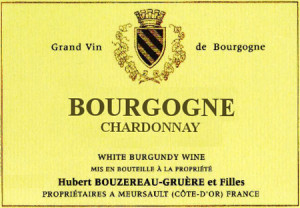
Bourgogne Blanc
Location: This wine is produced from vineyards planted in Meursault
Grape Variety: 100% Chardonnay
Harvest: Manual
Vinification: Pneumatic pressing, débourbage, alcoholic fermentation without yeast, malolactic fermentation
Aging: Maturation in oak barrels with 20-25% new wood on the lees for 1 year with regular bâtonnage
Tasting Notes: Fine minerality and complex palate. Nutty aromas and notes of vanilla, lemon, and peach with a flinty edge.
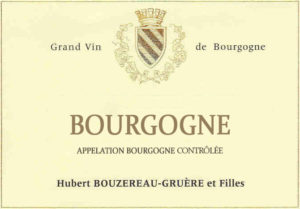
Bourgogne Rouge
Location: This wine comes from a plot of vines located behind the Estate called “Les Pelles.”
Grape Variety: 100% Pinot Noir
Production Area: 0.26 hectares
Yield: 50 hl/ha
First Planting: 1959
Harvest: Manual
Vinification: Traditional vinification. Pneumatic pressing, racking, fermentation without adding yeast, malolactic fermentation. The wine is aged in 20-30% new oak barrels in the cellar for 12 months. The wine is then bottled on the property within 12 to 18 months depending on the vintage and will wait a few months before being marketed.
Tasting Notes: Brilliant ruby color. The nose is pleasant and fruity with elegant notes of red fruit. Very enjoyable when consumed young, but also has fantastic aging potential.
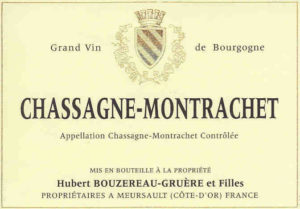
Chassagne-Montrachet Blanc
Soil: Clay limestone
Grape Variety: 100% Chardonnay
Year of First Planting: 2003
Production Area: 0.54 hectares
Yield: 46 hl/ha
Harvest: Manual
Vinification: Pneumatic pressing; débourbage; alcoholic fermentation without yeasts; malolactic fermentation
Aging: In oak barrels (25% new wood). Aging on the lees with regular bâtonnage. Bottled on the estate.
Cellaring Potential: 5-8 years
Tasting Notes: Generous structure, fragrant, elegant, and precise. This young wine is delightfully fruity and quite pleasant to drink while young.
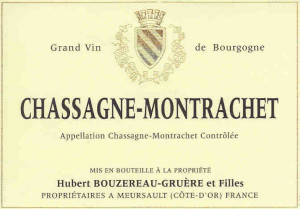
Chassagne-Montrachet Rouge
Location: This wine is produced from several different plots of vines in Chassagne: Les Bouchons de Corvée, Le Poirier du Clos, and La Corvée
Grape Variety: 100% Pinot Noir
Production Area: 0.66 hectares
Average Yield: 48 hl/ha
First Planting: 1971- 1972
Terroir: Reddish and stony soil, brown and limestone
Harvest: Manual into cases
Vinification: Traditional; aging in oak barrels for 18 months (20% new wood). Bottled on the estate
Tasting Notes: Brilliant ruby color. The nose is pleasant and fruity with elegant notes of red fruit. Very enjoyable when consumed young, but also has fantastic aging potential.
Cellaring Potential: 10-12 years
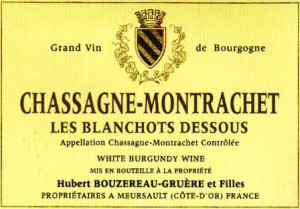
Chassagne-Montrachet Les Blanchots Dessous
Location: This plot is particularly well situated along the extension of Grands Crus Criots Bâtards Montrachet
Grape Variety: 100% Chardonnay
Year of First Planting: 1972
Production Area: 0.23 hectares
Average Yield: 48 hl/ha
Soil: Pebbly limestone
Harvest: Manual
Vinification: Pneumatic pressing, débourbage, alcoholic fermentation without yeast, malolactic fermentation
Aging: Maturation in oak barrels with 30% new wood on the lees for 1 year with regular bâtonnage
Tasting Notes: The noble terroir is beautifully expressed in this wine. Green reflections, with fragrances of white flowers, honeysuckle, and chamomile. The palate expresses white peach. Ripe fruit notes and a lovely minerality give this wine good balance.
Cellaring Potential: 8-10+ years
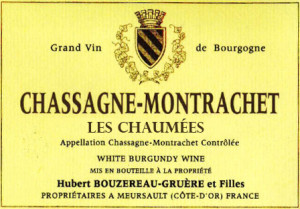
Chassagne-Montrachet 1er Cru Les Chaumées
Location: The vines are situated on a slope facing northeast, to the left of the quarry of Chassagne which is celebrated for its marble stone
Grape Variety: 100% Chardonnay
First Planting: 1975
Production Area: 0.5 hectares
Average Yield: Between 48-50 hl/ha
Harvest: Manual
Terroir: Pebbly limestone soil
Vinification: Pneumatic pressing, débourbage, alcoholic fermentation without yeast, malolactic fermentation
Aging: In oak barrels (30% new wood) sur lies with regular bâtonnages. Bottled at the estate
Cellaring Potential: 8-10 years or more
Tasting Notes: Pale yellow color with shades of green. Aromas of citrus and exotic fruit, as well as a lovely minerality and aromatic purity
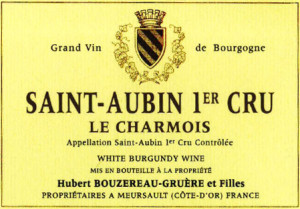
Saint-Aubin 1er Cru Le Charmois
Location: This plot of southern-facing vines is neighbor to the appellation of Chassagne Montrachet 1er Cru les Chaumées and is one of the best Premier Crus of Saint Aubin
Grape Variety: 100% Chardonnay
Year of First Planting: 1972-1975
Production Area: 0.33 hectares
Average Yield: 48-50 hl/ha
Soil: White clay and limestone
Harvest: Manual
Vinification: Pneumatic pressing, débourbage, alcoholic fermentation without yeast, malolactic fermentation
Aging: Maturation in oak barrels with 25% new wood on the lees for 1 year with regular bâtonnage
Tasting Notes: Beautiful pale color and a lemony nose, typical of Saint Aubin Premier Cru. The roundness, consistency, and the freshness of the citrus notes give good balance to this wine.
Cellaring Potential: 8-10 years
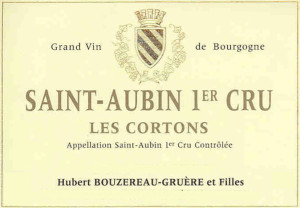
Saint-Aubin 1er Cru Les Cortons
Location: This plot is situated on a marked slope, behind Le Montrachet, on the opposite side of Saint Aubin 1er Cru Le Charmois, and above the hamlet of Gamay. Oriented to the south-southwest, this Saint Aubin 1er Cru could equally be called Saint Aubin 1er Cru “En Remilly.”
Grape Variety: 100% Chardonnay
Year of First Planting: 1988
Production Area: 0.28 hectares
Average Yield: 50 hl/ha
Soil: White clay and limestone
Harvest: Manual
Vinification: Pneumatic pressing, débourbage, alcoholic fermentation without yeast, malolactic fermentation
Aging: Maturation in oak barrels with 25% new wood on the lees for 1 year with regular bâtonnage
Tasting Notes: Brilliant appearance with shades of gold. This wine has much freshness and finesse, and a fluid body. Refined and elegant.
Cellaring Potential: 8-10 years
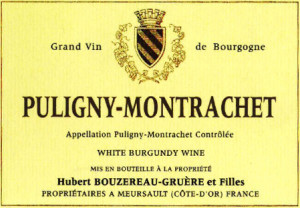
Puligny-Montrachet
Location: A parcel of land called “Les Houillères” located on the edge of Chassagne-Montrachet
Grape Variety: 100% Chardonnay
Year of First Planting: 1972
Production Area: 0.5 hectares
Average Yield: 50 hl/ha
Soil: Clay limestone
Harvest: Manual
Vinification: Pneumatic pressing, débourbage, alcoholic fermentation without yeast, malolactic fermentation
Aging: Maturation in oak barrels with 25% new wood on the lees for 1 year with regular bâtonnage
Tasting Notes: Much freshness and finesse; the nose expresses acacia, hazelnut, toasted almond, vanilla, and white pepper.
Cellaring Potential: 5-8 years
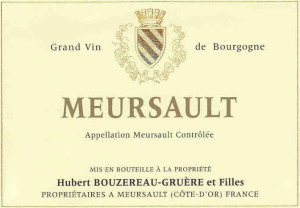
Meursault Blanc
Location: This wine is produced from a plot of wines behind the domaine called “Les Pelles.”
Grape Variety: 100% Chardonnay
Production Area: 0.26 hectares
Year of First Planting: 1959
Average Yield: 50 hl/ha
Soil: Clay limestone
Harvest: Manual
Vinification: Traditional
Aging: Maturation in oak barrels for 11-12 months (20-30% new wood)
Tasting Notes: Very heady bouquet, with aromas of almond, honey, and hot, crusty bread-beautiful aromatic complexity typical of the vintage. On the palate, the wine has an abundant richness which verges on unctuousness, and has notes of ripe and dried fruit (such as apricots). Vivacious with great length; this is a very elegant wine.
Cellaring Potential: 5-10 years
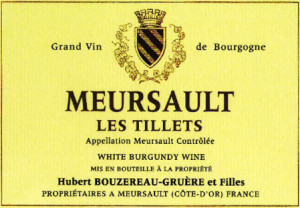
Meursault Les Tillets
Location: This wine is produced from 2 plots situated one below the other on the hills of Meursault
Grape Variety: 100% Chardonnay
Production Area: 0.83 hectares
Year of First Planting: 1961
Average Yield: 50 hl/ha
Soil: Limestone & marl
Harvest: Manual
Vinification: Pneumatic pressing, débourbage, alcoholic fermentation without yeast, malolactic fermentation
Aging: Maturation in oak barrels with 25% new wood on the lees for 1 year with regular bâtonnage
Tasting Notes: This wine has beautiful minerality which awakens the taste buds; notes of grapefruit and lemon are present. The oak is present but only slightly so, and pairs delicately with the bouquet of the wine.
Cellaring Potential: 5-10 years
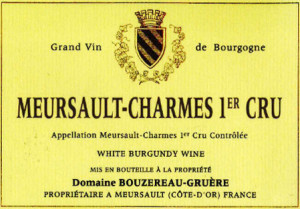
Meursault-Charmes 1er Cru
Location: Meursault-Charmes is one of the most beautiful Premier Crus of Meursault. This wine is produced from 2 plots: Charmes Dessus and Charmes Dessous. The vines planted in Charmes Dessus bring a minerality and vivacity to the resulting wine, whereas the Charmes Dessous vines bring fruitiness and good concentration. The blending of these two plots results in a very well-balanced wine with superb aromatic complexity.
Grape Variety: 100% Chardonnay
Production Area: 0.6 hectares (Meursault Charmes Dessus-0.3 hectares; Meursault Charmes Dessous-0.3 hectares)
Year of First Planting: 1959
Average Yield: 45-48 hl/ha
Soil: Stoney clay
Harvest: Manual
Vinification: Pneumatic pressing, débourbage, alcoholic fermentation without yeast, malolactic fermentation
Aging: Maturation in oak barrels with 30% new wood on the lees for 1 year with regular bâtonnage
Tasting Notes: Very elegant yet direct wine with aromas of citrus, white flowers, and a light minerality. Good length and superb balance, with finesse and richness on the palate. This wine’s purity and elegance distinguishes it as one of the great wines of Meursault.
Cellaring Potential: 10+ years
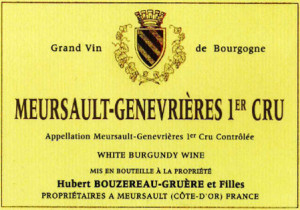
Meursault-Genevrières 1er Cru
Location: This wine is produced from 4 rows of vines that the Bouzereau family owns in the prestigious Premier Cru Meursault-Genevrières, located in the south of Meursault and directly above the climats of Les Perrieres and Les Charmes
Grape Variety: 100% Chardonnay
Average Age of Vines: 60 years old
Annual Production: 50-60 cases; production is extremely limited
Harvest: Manual
Vinification: Pneumatic pressing, débourbage, alcoholic fermentation without yeast, malolactic fermentation
Aging: Maturation in oak barrels with 40% new wood on the lees for 1 year with regular bâtonnage
Tasting Notes: The generosity of the attack is followed by a refined palate with elegant tension. Luscious notes of honey, toasted nuts, and butterscotch.
Cellaring Potential: 5-8 years
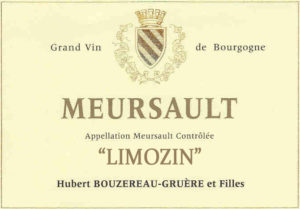
Meursault Limozin
Location: This plot is situated below Meursault Genevrières; it shares one of the best terroirs of the appellation.
Grape Variety: 100% Chardonnay
Year of First Planting: 1969
Production Area: 0.73 hectares
Average Yield: 27 hl/ha
Harvest: Manual
Soil: Clay limestone
Vinification: Pneumatic pressing; débourbage; alcoholic fermentation without yeasts; malolactic fermentation
Aging: In oak barrels (25% new wood). Aging on the lees with regular bâtonnage. Bottled on the estate.
Cellaring Potential: 5-10 years
Tasting Notes: Beautiful, brilliant color. The nose is discreet with notes of grapefruit and young, green lemon. The vivacity of the citrus is also present on the palate and blends perfectly with the woodsy foundation of this wine.
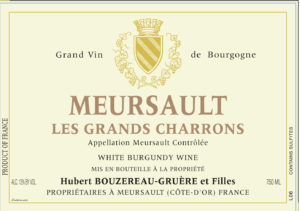
Meursault Les Grands Charrons
Overview: The Meursault Les Grands Charrons is a single-vineyard village wine located just behind the family’s home. The Grand Charrons plot is as close to being Premier Cru as possible. It is situated exactly in line with the major Premier Cru parcels on the slope in Meursault.
Grape Variety: 100% Chardonnay
Average Age of the Vines: 35 years old
Cellaring: 4-6 years
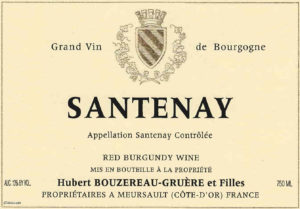
Santenay Rouge
Location: This wine is sourced from 2 different plots in Santenay: Les Hâtes and les Prarons
Soil: Reddish-brown, stony soil with limestone
Grape Variety: 100% Pinot Noir
Production Area: 0.25 hectares
Average Yield: 35 hl/ha
Years of First Planting: 1970-1971
Harvest: Manual
Vinification: Traditional vinification; maturation in oak barrels for 12-18 months (20% new wood). Bottled on the estate.
Tasting Notes: Brilliant ruby color. The bouquet is fragrant with notes of elegant red fruit. Very enjoyable when consumed young, but with great cellaring potential as well.
Cellaring Potential: 8-10 years
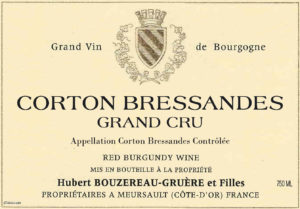
Corton Bressandes Grand Cru
Location: This Grand Cru plot, situated in the commune of Aloxe Corton, was purchased by Hubert Bouzereau in 1971. The vines are planted on the hill of Cortons about 15 kilometers from Meursault. The winemaker is proud to vinify a Grand Cru rouge in Meursault, at the source of the white Grand Vins of Côte de Beaune.
Grape Variety: Pinot Noir
Production Area: 0.14 hectares
Yield: 40 hl/ha
First Planting: 1972
Terroir: Gently sloping plot with reddish-brown, limestone rocky soil. Rich in marl and potash.
Harvest: The grapes are picked manually and placed into boxes
Vinification: Traditional methods
Aging: In oak barrels for 18 months (30% new wood). Bottled at the domaine.
Tasting Notes: Deep, garnet red color. Pleasantly fruity on the nose, with notes of ripe black cherries and vanilla on the palate.
Serving Suggestion: To be consumed immediately or can be cellared for 12-20 years.
Domaine Launay Horiot

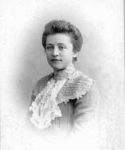
Mélanie Laly-Launay in 1819
The Estate
This family-owned domaine is profoundly attached to the history of the Burgundy terroir. At the end of the 18th century, Jean Baptiste Laly, landowner in Chassagne-Montrachet, passed on his vineyard to his daughter, Mélanie. At the beginning of the 19th century, Mélanie married Ferdinand Launay and the family settled in Pommard. Over time, the family slowly acquired a property of 11.5 hectares, stretching from the Beaune to the Nuits coasts.

Xavier Horiot – Air Force Pilot
Xavier Horiot, descendant of the Launays, was inspired by the legacy of his great uncle Bertrand who was a fighter pilot during World War II. Xavier began his professional life as a fighter pilot, and was enlisted in the French Air Force for 18 years. He was eventually named knight of the Legion of Honor, and given the Croix de Guerre for his service.
Shortly before he died, Xavier’s grandfather, Raymond Launay, left 4 hectares of the family estate to his daughter and to Xavier. Raymond soon learned that his daughter planned to sell all of her inheritance after his death. This was devastating blow as Raymond had had a lifelong dream of reviving the family vineyards. There was nothing he could do however, due to the strict inheritance laws in France.
Upon Raymond’s death in 2000, Xavier, who at the time was still enlisted in the air force, decided that he would devote himself to fulfilling his grandfather’s dream and would fight for ownership of the family vineyards. A decade of legal fights ensued, tearing the family apart. In 2011, the courts finally ruled in his favor and Xavier was given full ownership of the 4 hectares of precious vineyards. Included in these 4 hectares were 2.2 hectares in Pommard Les Perrieres (planted in 1902), as well as old vines in the Pommard 1er Cru vineyards of Les Rugien Bas (0.09 ha), Les Chaponnieres (0.59 ha), and Clos Blanc (0.17 ha). In addition, there were 2 excellent Grand Cru holdings in Gevrey-Chambertin: 0.17 hectares of Latricières-Chambertin (next to the vines of Pierre Duroche), and 0.16 hectares of Chambertin (next to the vines of Lalou Bize-Leroy).
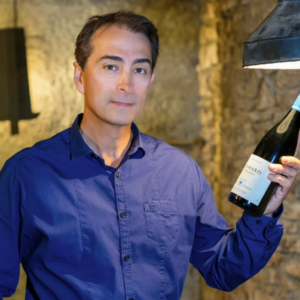
Xavier Horiot – Winemaker
Xavier resigned from the air force and returned to Pommard where he dedicated himself to reviving the estate in his grandfather’s honor. With depleted resources after the years-long legal battle, restarting the vineyard was a difficult endeavor. For the first 3 years, Xavier worked the vineyards by hand and sold most of his crop to neighboring wineries so that he could afford to purchase vineyard equipment. After years of hard work and dedication, Xavier finally was able to produce his first vintage in 2014 with the help of consultant Veronique Girard. Soon after, critics began to visit the domaine and review his wines, which were praised consistently for their unique expression of the terroir. Xavier’s wines have gone on to gain serious recognition from the Burgundy-loving crowd.
The Logo
The domaine’s logo represents Xavier’s long journey from fighter pilot to winemaker. It is an intersection of wings and swords that forms a light blue “X”. The wings stand for Xavier’s history in the air force, as well as the purity he seeks to achieve in his wines. The swords stand for the battles won, and also to symbolize the tools used to plow his ancestors’ land.


Pommard Les Perrières
Vineyard Area: 2.20 hectares
First Planting: 1902
Grape Variety: 100% Pinot Noir
Viticulture: Winemaker Xavier Horiot’s approach to the vines is respectful and reasoned, following the principles of “lutte raisonnée”. The soils are tilled and treatments are strictly limited to what is necessary.
Harvest: The grapes are harvested by hand into small 11 kg boxes so that they arrive intact to the sorting tables where they are carefully sorted.
Vinification: The grapes are fully destemmed to remove the herbaceous taste of the stems from the juice. Xavier likes to keep the grapes whole for as long as possible so that they may fully develop their aromatic profile. The grapes remain in cold pre-fermentation maceration for 6 to 8 days; no punching down. Fermentation takes place with only indigenous yeasts. Temperature control allows for 4-5 weeks of vatting every year. Pigeages and pump-overs follow 1-2 times per day to achieve the desired extraction.
Aging: The wine remains for 12-16 months in oak barrels and then 1-2 months in vats before bottling (no fining or filtration). The proportion of new oak is adapted to each appellation and varies from 15-75% (Usually Pommard receives 1/3 new oak, Pommard Grand Cru 2/3 new oak).
Alcohol: 13.0%
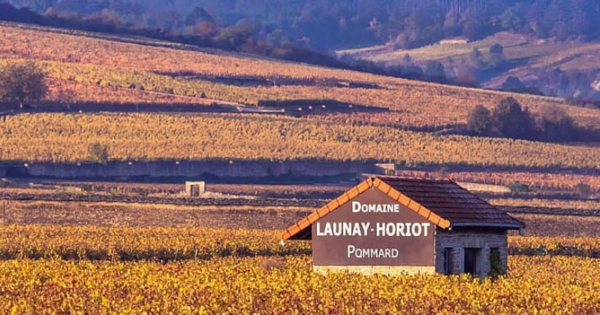

Pommard 1er Cru Les Chaponnières
Location: Les Chaponnières is situated just below Les Rugiens-Bas plot.
Vineyard Area: 0.59 hectares
Soil: Les Chaponnières has much deeper and less iron-rich soils than its neighbor to the north, Les Rugiens-Bas.
Grape Variety: 100% Pinot Noir
Viticulture: Winemaker Xavier Horiot’s approach to the vines is respectful and reasoned, following the principles of “lutte raisonnée”. The soils are tilled and treatments are strictly limited to what is necessary.
Harvest: The grapes are harvested by hand into small 11 kg boxes so that they arrive intact to the sorting tables where they are carefully sorted.
Vinification: The grapes are fully destemmed to remove the herbaceous taste of the stems from the juice. Xavier likes to keep the grapes whole for as long as possible so that they may fully develop their aromatic profile. The grapes remain in cold pre-fermentation maceration for 6 to 8 days; no punching down. Fermentation takes place with only indigenous yeasts. Temperature control allows for 4-5 weeks of vatting every year. Pigeages and pump-overs follow 1-2 times per day to achieve the desired extraction.
Aging: The wine remains for 12-16 months in oak barrels and then 1-2 months in vats before bottling (no fining or filtration). The proportion of new oak is adapted to each appellation and varies from 15-75% (Usually Pommard receives 1/3 new oak, Pommard Grand Cru 2/3 new oak).
Tasting Notes: Amazing nose with notes of dark, ripe cherries. Elegant, direct, and clean with great structure.
Alcohol: 13.0%
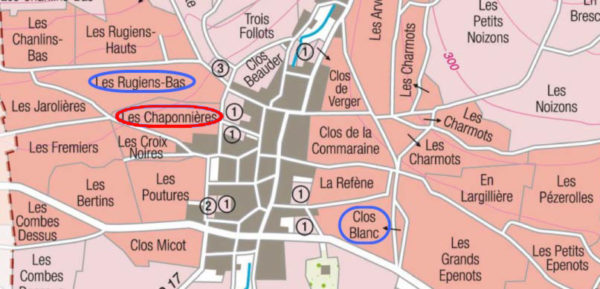

Pommard 1er Cru Clos-Blanc
Location: The northern side of Pommard, close to Les Grands Epenots, which receives cooling breezes from the Combe Nantoux.
Vineyard Area: 0.17 hectares
Soil: White clay-limestone
Grape Variety: 100% Pinot Noir
Viticulture: Winemaker Xavier Horiot’s approach to the vines is respectful and reasoned, following the principles of “lutte raisonnée”. The soils are tilled and treatments are strictly limited to what is necessary.
Harvest: The grapes are harvested by hand into small 11 kg boxes so that they arrive intact to the sorting tables where they are carefully sorted.
Vinification: The grapes are fully destemmed to remove the herbaceous taste of the stems from the juice. Xavier likes to keep the grapes whole for as long as possible so that they may fully develop their aromatic profile. The grapes remain in cold pre-fermentation maceration for 6 to 8 days; no punching down. Fermentation takes place with only indigenous yeasts. Temperature control allows for 4-5 weeks of vatting every year. Pigeages and pump-overs follow 1-2 times per day to achieve the desired extraction.
Aging: The wine remains for 12-16 months in oak barrels and then 1-2 months in vats before bottling (no fining or filtration). The proportion of new oak is adapted to each appellation and varies from 15-75% (Usually Pommard receives 1/3 new oak, Pommard Grand Cru 2/3 new oak).
Alcohol: 13.0%
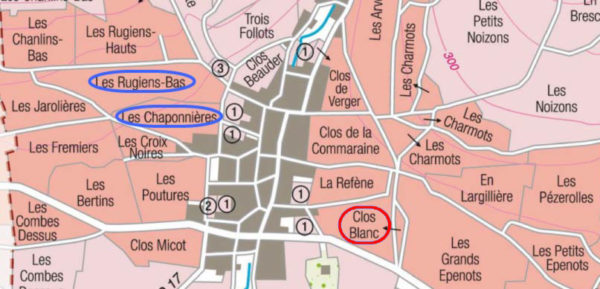

Pommard 1er Cru Les Rugiens Bas
Vineyard Area: 0.09 hectares
Soil: Rich in iron-oxide
Grape Variety: 100% Pinot Noir
Viticulture: Winemaker Xavier Horiot’s approach to the vines is respectful and reasoned, following the principles of “lutte raisonnée”. The soils are tilled and treatments are strictly limited to what is necessary.
Harvest: The grapes are harvested by hand into small 11 kg boxes so that they arrive intact to the sorting tables where they are carefully sorted.
Vinification: The grapes are fully destemmed to remove the herbaceous taste of the stems from the juice. Xavier likes to keep the grapes whole for as long as possible so that they may fully develop their aromatic profile. The grapes remain in cold pre-fermentation maceration for 6 to 8 days; no punching down. Fermentation takes place with only indigenous yeasts. Temperature control allows for 4-5 weeks of vatting every year. Pigeages and pump-overs follow 1-2 times per day to achieve the desired extraction.
Aging: The wine remains for 12-16 months in oak barrels and then 1-2 months in vats before bottling (no fining or filtration). The proportion of new oak is adapted to each appellation and varies from 15-75% (Usually Pommard receives 1/3 new oak, Pommard Grand Cru 2/3 new oak).
Alcohol: 13.0%
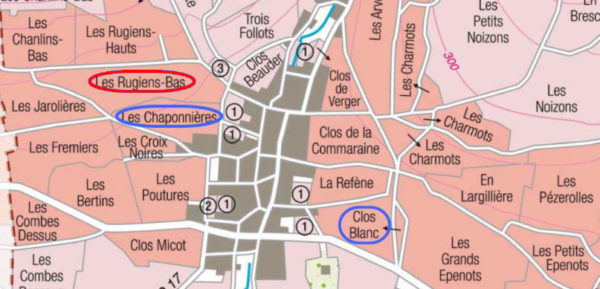

Latricières-Chambertin Grand Cru
Location: This wine is produced from a tiny plot at the top of the vineyard next to Chambertin, next to the vines of Pierre Duroche.
Vineyard Area: 0.17 hectares
Grape Variety: 100% Pinot Noir
Viticulture: Winemaker Xavier Horiot’s approach to the vines is respectful and reasoned, following the principles of “lutte raisonnée”. The soils are tilled and treatments are strictly limited to what is necessary.
Harvest: The grapes are harvested by hand into small 11 kg boxes so that they arrive intact to the sorting tables where they are carefully sorted.
Vinification: The grapes are fully destemmed to remove the herbaceous taste of the stems from the juice. Xavier likes to keep the grapes whole for as long as possible so that they may fully develop their aromatic profile. The grapes remain in cold pre-fermentation maceration for 6 to 8 days; no punching down. Fermentation takes place with only indigenous yeasts. Temperature control allows for 4-5 weeks of vatting every year. Pigeages and pump-overs follow 1-2 times per day to achieve the desired extraction.
Aging: The wine remains for 12-16 months in oak barrels and then 1-2 months in vats before bottling (no fining or filtration). The proportion of new oak is adapted to each appellation and varies from 15-75% (Usually Pommard receives 1/3 new oak, Pommard Grand Cru 2/3 new oak).
Alcohol: 13.0%
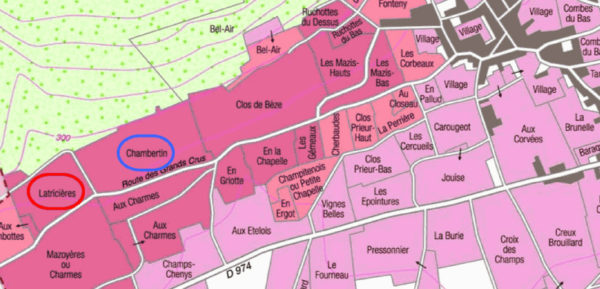

Chambertin Grand Cru
Vineyard Area: 0.16 hectares divided into 3.5 parcels, next to the vines of Lalou Bize-Leroy.
First Planting: 1960s
Grape Variety: 100% Pinot Noir
Viticulture: Winemaker Xavier Horiot’s approach to the vines is respectful and reasoned, following the principles of “lutte raisonnée”. The soils are tilled and treatments are strictly limited to what is necessary.
Harvest: The grapes are harvested by hand into small 11 kg boxes so that they arrive intact to the sorting tables where they are carefully sorted.
Vinification: The grapes are fully destemmed to remove the herbaceous taste of the stems from the juice. Xavier likes to keep the grapes whole for as long as possible so that they may fully develop their aromatic profile. The grapes remain in cold pre-fermentation maceration for 6 to 8 days; no punching down. Fermentation takes place with only indigenous yeasts. Temperature control allows for 4-5 weeks of vatting every year. Pigeages and pump-overs follow 1-2 times per day to achieve the desired extraction.
Aging: The wine remains for 12-16 months in oak barrels and then 1-2 months in vats before bottling (no fining or filtration). The proportion of new oak is adapted to each appellation and varies from 15-75% (Usually Pommard receives 1/3 new oak, Pommard Grand Cru 2/3 new oak).
Alcohol: 13.0%
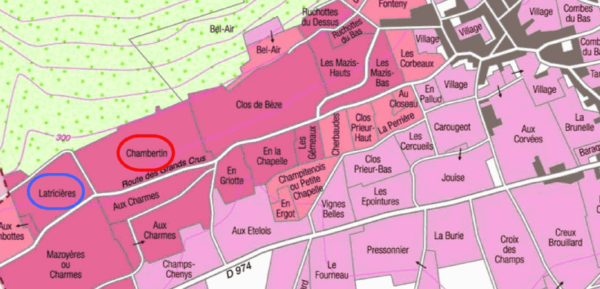
Domaine Laurent Cognard (Sustainable)
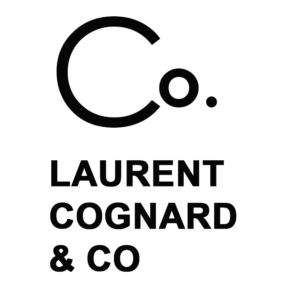
The Estate
The estate is situated in Buxy, Burgundy in the Montagny appellation, which is the southern gateway to the Côte Chalonnaise. The Cognard family has its origins in the Mâconnais region, but Laurent is a local boy who always cherished the idea of settling in Buxy and founding his own Domaine. He acquired his first vineyards in 1997, and became a full-time winemaker in 2006, cultivating an area of 5.5 hectares. Today, he manages 18 hectares of vines spread over Loché, Montagny, and Mercurey with 6.4 hectares in Montagny 1er Cru.
The estate was initially headquartered in an ancient prison dating back to the middle ages in a picturesque but somewhat narrow cellar. He moved the Domaine to the Château de Buxy in the heart of the town and built a tasting cellar and a state-of-the-art winery more in keeping with the burgeoning development of the estate.
Vinification
Seeking to make balanced wines, Laurent prefers healthy grapes picked at their optimal ripeness. All the vineyard soils are ploughed to force the vine roots to plumb the depths of the terrain. The domaine limits phytosanitary treatments with the aim of obtaining a TERRA VITIS reconversion ( H.V.E. equivalent) in 2020.
In the cellar, Laurent upholds Burgundian tradition but brings his own nod to modernity. Similarly, the wines are aged in 500 liter casks – an unfamiliar format but which Laurent believes underscores the minerality in his white wines.
“I like wines with good freshness and balance giving fine drinkability. A good bottle is an empty one and – as my grandfather was fond of saying – a Magnum is the ideal format for a couple (over dinner) especially if the wife doesn’t drink.”
The Region
The vineyard is located in Burgundy-Franche-Comté in the departments of Yonne, Côte-d’Or, and Saône-et-Loire. It extends over 250 km in length from the north of Chablis to the south of the Mâconnais.
The Burgundian vineyard includes 84 appellations d’origine contrôlée (AOC): 6 regional appellations, 45 communal or village appellations (with 562 premiers crus names on these village appellations) and 33 grands crus appellations.
The fruit of a long history, Burgundy and its wines are renowned throughout the world and have been included on the UNESCO World Heritage List since 2015.

Bourgogne Pinot Noir
Location: Situated in the Côte chalonnaise, in the commune of Bissey-Sous-Cruchaud. The name of the southerly-facing plot is “Les Terrettes” which is approximately 300 meters above sea level.
Soil: Clay-marl
Surface Area: 1 hectare
Grape Varieties: 100% Pinot Noir
Harvest: Hand-picked grapes
Vinification: Cold maceration for 4-7 days. Fermentation lasts about 10 days. No “pigeage” in order to preserve the fruit and avoid tannins extraction.
Aging: 100% old oak barrels for 11-12 months.
Tasting Notes: Notes of red fruits in the bouquet – cherry and redcurrant. Smooth and generous on the palate; cherry notes with soft tannins on the attack. This pleasant and fruity wine will be great at any time of the day, for unexpected visits.
Serving Suggestion: Serve at 12-14°C. This is a fresh wine to be enjoyed within 5 years of the vintage.

Bourgogne Chardonnay
Location: Laurent’s parents planted those vines only 50m away from the Montagny appellation area. The name of the plot is “Les Champs de Perdrix” which has an easterly exposure.
Soil: Clay-limestone
Surface Area: 0.64 hectares
Average Age of the Vines: 30 year-old vines
Grape Varieties: 100% Chardonnay
Harvest: Hand-picked
Vinification: Grapes are carefully pressed, and the wine is naturally clarified due to gravity.
Aging: Combination of 500L old oak barrels and stainless steel vats (the proportion of each varies depending on the vintage) for 10-12 months.
Tasting Notes: Fresh and elegant nose, with notes of white fruit and Acacia flower. Fine density on the palate, well-balanced with citrus and dry, fruity notes.
Serving Suggestion: Serve at 9-10°C. This is a fresh wine to be enjoyed within 3 years of vintage.

Mâcon-Loché Les Longues Terres
Overview: Originally planted by Laurent’s grandfather, Laurent took over ownership of these vines in 2018 from his uncle.
Plot: “Les Longues Terres” is a hillside plot with eastern exposure planted with 40 year old vines.
Region: Burgundy – Mâconnais – Loché
Soil: Clay limestone
Grape Variety: 100% Chardonnay
Harvest: Manual
Vinification: Light pressing; debourbage by gravity; vinification in thermo-regulated stainless steel tanks.
Aging: 10-12 months in steel tanks
Tasting Notes: Limpid, brilliant golden color with green reflections. Notes of pear and dried fruit on the nose. On the palate, the attack is round and crisp. Beautiful freshness with hints of white fruit. Notes of citrus on the finish.
Serving Suggestion: To be consumed within 3 years of the vintage.

Montagny 1er Cru Les Bassets
Overview: Historic vines owned by Laurent’s parents, recovered in 2002. The first Montagny Premier Cru of the domaine.
Region: Burgundy – Cote Chalonnaise – Buxy
Terroir: Les Bassets plot. Slopes due east. Altitude 250m.
Soil: Clay-limestone
Vines: 1.35 ha (40 years old) plus 1.1 ha (20 years old)
Grape Varieties: 100% Chardonnay
Harvest: Manual
Vinification: Gentle pressing, settling by gravity.
Aging: SOOL French oak barrels (<10% new wood). Aging for 11-12 months.
Tasting Notes: Clear and brilliant with golden reflections. Good density – fruity on the palate with notes of Accacia flower and peach. Saline expression of minerality on the finish. Elegant and fresh.
Serving Suggestion: 10-11 °C. To be consumed within 5 years of vintage.
2018 Reviews: “Aromas of pear, peach, orange oil and toasted almonds introduce the 2018 Montagny 1er Cru Les Bassets, a medium to full-bodied, satiny wine with a pretty core of fruit and tangy balancing acids. It has turned out well.” – William Kelley, Wine Advocate
Domaine Les Garçons (Certified Biodynamic)

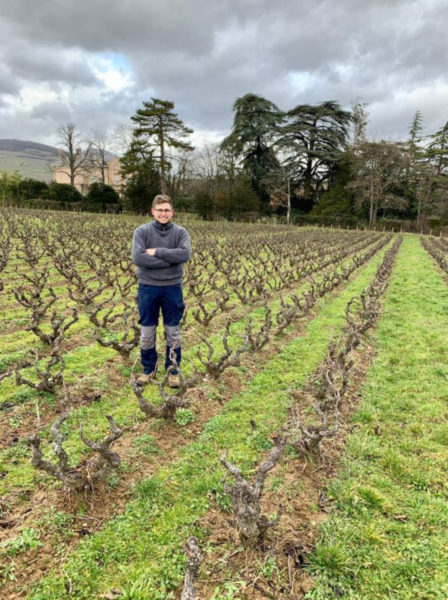
The Estate
Born in 1995, Loïc Crespin has been working among the vines since he was 6 years old. Behind the handsome exterior and affable charm, one detects a steely determination. His parents, Jean-Pierre and Isabelle Crespin, are proprietor/vignerons in Charentay producing Brouilly and Côte de Brouilly. While Loïc admired his parents’ dedication to their vines, he felt he could take his enterprise to another level. He first attended the Lycée at Bel-air, and then did a 2-year apprenticeship and obtained a B.T.S. at Domaine Durieu in Châteauneuf-du-Pape.
Loïc has 2 all-consuming hobbies: fishing and mushrooms. These both lead him to become passionately interested in biodynamics. He enrolled in a biodynamics course which is compulsory if a Domaine is to be certified.
Loïc eventually met Fabien Pinguet, a native of Savoy working in the high-end restaurant industry. After many exchanges, they both had the same idea, to work together in the vineyard to give birth to what would become the Domaine Les Garçons.
Their first harvest was 2020, and they vinified 2 hectares worth of old vine Brouilly. Domaine les Garçons was fully Demeter-certified biodynamic by the 2021 vintage, joining a select band of fewer than 10 Demeter-certified vignerons in Beaujolais. In addition, they have thought long and hard about presentation: their bottles have wax capsules, long, high quality corks, and sport a sensational wooden label.
The estate spans about 7 hectares in the heart of Beaujolais, in the commune of Charentay. While they continues to supply grapes to the most prestigious estates in the area, Loïc is firmly committed to carving out a reputation for his own wines. Although Brouilly remains the cornerstone of his range, other appellations include Beaujolais Village and Beaujolais Blanc.
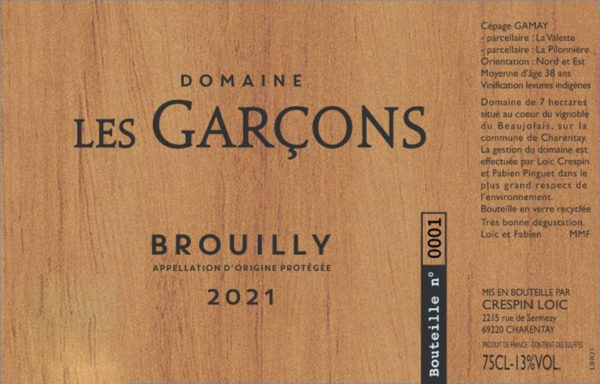
Domaine Les Garçons Brouilly
Plots: La Valette and La Pilonniere
Orientation: North and east
Grape Variety: 100% Gamay
Average Age of the Vines: 38 years old
Vinification: Traditional Beaujolais, semi-carbonic maceration with whole bunches. Indigenous yeasts are used.
Aging: Partly in 228-liter barrels and stainless-steel tanks, Loïc leaves a higher level of C02 at bottling which allows him to drastically reduce sulfur levels.
Tasting Notes: On the nose, it is aromatic, with intense notes of iris and dark, brambly fruit underneath. Vinous, fleshy, and powerful on the palate with a nice grip on a long, grapey finish.
Alcohol: 13.0%
Domaine Marsoif
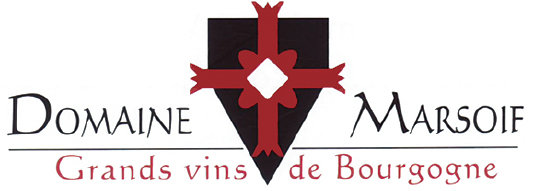
The Estate
Domaine Marsoif is a family estate taken over in 2005 by the artisan winemaker and president of the Bourgogne Tonnere appellation, Raphaël Masson. The name Marsoif is derived from “Marchesoif”, which was the base of a 13th century order of the Knights Templar surrounded by ponds and vineyards. You can find a call back to the Templar theme on all the Marsoif labels. In 2008, Masson expanded the domaine by purchasing plots in Epineuil. The 10.5 hectare, sustainably managed vineyard is planted half with Pinot Noir and half with Chardonnay. Their range of gourmet and fruity wines includes rouge, blanc, rosé, and 2 crémants – all domaine-bottled since Masson has taken ownership.
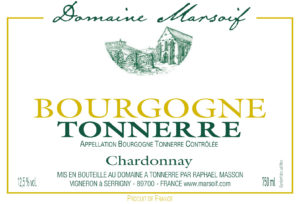
Bourgogne Tonnerre Chardonnay
Grape Variety: 100% Chardonnay
Average Age of the Vines: 20 years old
Yield: 4,000 bottles
Alcohol: 12.5%
Vinification: The wine is vinified and aged in tank.
Tasting Notes: Pale, straw color with green reflections. The nose is fine with notes of peach and apricot, married with hints of spring wildflowers like hawthorn and acacia. With decanting, the wine has richer fragrances of candied lemon, zest, and beeswax. On the palate, there is suppleness and fragrance at the start. Lemony and tangy flavors lend this wine freshness. With age, it develops substance and fairly good volume. We have a very good balance between fullness and freshness, which makes this wine available from start to finish. Lovely acidity on the finish.
Food Pairings: Seafood
Serving Temperature: 8-10°C
Cellaring: 2 years
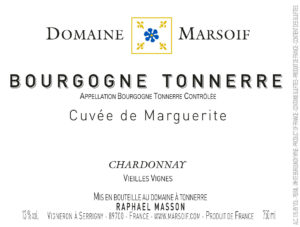
Bourgogne Tonnerre Cuvée De Marguerite Vieilles Vignes
Overview: “Cuvée De Marguerite” is an homage to Raphaël Masson’s grandmother, as well as Marguerite de Bourgogne (born in Tonnerre).
Grape Variety: 100% Chardonnay
Average Age of the Vines: 30 years old
Yield: 3,500 bottles
Alcohol: 13%
Vinification: Cement tank
Tasting Notes: Straw yellow color with shades of gold. The nose is frank and precise, beginning with notes of pear and quince, with notes of ripe kiwi and kumquat in the background, followed by fragrances of grenadine and wild strawberry. On the palate, this wine has good structure with suppleness but also an acidic element that gives it tension and drive. Savors of juicy, fresh white, yellow, and exotic fruits. Hints of lemon meringue on the finish.
Food Pairings: Chicken with cream and mushrooms or braised turbot with morels. After swirling, there is white flowers, lemony touches and at the very end of the nose a mineral hint.
Serving Temperature: 9-10°C
Cellaring: 3-4 years
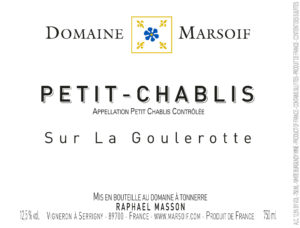
Petit Chablis Sur La Goulerotte
Grape Variety: 100% Chardonnay
Alcohol: 12.5%
Tasting Notes: Pale gold color, sparkling and limpid, with silvery green nuances. The nose is frank and engaging – notes of ripe apple, quince, and peach alongside floral touches of honeysuckle, hawthorn, and jasmine. After swirling, the nose opens with notes of lemon enhanced with a hint of mineral. On the palate, this Petit Chablis does the work – the attack is frank, fresh, and fleshy, with fruity and floral notes and a touch of lemon which gives it a vibrant and edgy side. With age, we have a dry wine with substance and a lovely freshness which lingers to the finish. On the whole, this wine is both light and dynamic with a pleasant austerity. The finish has notes of peach, lemon, and a touch of minerality.
Food Pairings: Oysters, crab, or shrimp.
Serving Temperature: 9-10°C
Cellaring: 2-3 years
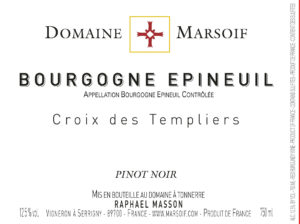
Bourgogne Epineuil Croix Des Templiers
Grape Variety: 100% Pinot Noir
Soil: Clay (more in Epineuil than Tonnerre)
Yield: 8,500 bottles
Alcohol: 12.5%
Tasting Notes: Limpid and brilliant ruby color. The nose is still quite young. Pleasant and lively, it develops aromas of strawberry, raspberry, and cherry, tinged with a floral hint. On the palate, this is a frank wine, still a little fiery, animated by a beautiful liveliness. Relatively smooth and light structure that lets the fruit express itself. Tart finish with a discreet touch of spice which adds to the charm of this wine.
Food Pairings: Flank steak with shallots or veal.
Serving Temperature: 15-16°C
Cellaring: 3 years
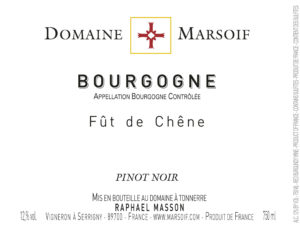
Bourgogne Rouge Fût De Chêne
Grape Variety: 100% Pinot Noir
Soil: Limestone
Yield: 1,200 bottles
Alcohol: 12%
Vinification: The wine is vinified in cement tanks without punching down, followed by aging in old barrels.
Tasting Notes: Deep, shining garnet color. The bouquet is comforting, with a cornucopia of red fruit notes, such as strawberry, raspberry, and cherry, accompanied by floral notes of freesia and spice. With aeration, discreet notes of vanilla and cinnamon develop. The mouth is fresh and dapper. The attack is gourmand and fleshy with a clear reflection of the fragrances of the nose. A touch of spice on the finish.
Food Pairings: Beef cheek or roast veal.
Serving Temperature: 15-16°C
Cellaring: 2-4 years
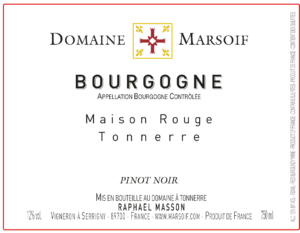
Bourgogne Pinot Noir Maison Rouge Tonnerre
Overview: This Bourgogne Pinot Noir takes its name “Maison Rouge” from the location of the cellar and principle wine cave of Marsoif since 2017.
First Planting: 1990s
Grape Variety: 100% Pinot Noir
Vinification: This wine is vinified in the traditional way, typical of the region. 80% “jus de presse” and 20% “jus de goutte”. No wood used.
Tasting Notes: Delicious, light, and fruit forward wine. Crunchy but well-balanced tannins. Lovely lingering finish.
Alcohol: 12%
Domaine Méo-Camuzet – Côte de Beaune, Côte de Nuits

The History
From Winegrowers to Engineers
For more than four centuries, the members of the Méo family have devoted themselves to growing vines and making wines. They came originally from the Burgundy village of Selongey, in the north of Côte d’Or, where today, even if the vines, alas, have disappeared, a pressing house, dating from the year 50 AD, bears witness to the presence there of Gallo-Roman winegrowers.
It was thanks to Jean Méo’s mother, Marcelle Lamarche-Confuron, originating from an old winegrowing family in Vosne (with already a small activity as négociants), that the Méos came to settle in Vosne-Romanée.
Jean Méo’s grandmother was the first cousin of Étienne Camuzet (1867-1946), a winegrower in Vosne-Romanée, mayor of the village, and also an MP for Côte d’Or from 1903 to 1932. In 1920, he had the opportunity to purchase the Château du Clos de Vougeot with some of the vines, but instead of living there, he preferred to lodge his tenant farmers in it as he no longer had time to look after his own vineyards. He was to sell it in November 1944 to the Confrérie des Chevaliers du Tastevin.
As for the vines, it was the 20 hectares (50 acres) at the top of the Clos that were for sale…Étienne Camuzet enlisted the help of his fellow winegrowers from Vosne-Romanée to acquire them. He would keep 3 hectares (7.5 acres) himself, immediately below the château.
Following the death of Étienne Camuzet, his daughter, Maria Noirot, inherited the estate and retained the tenant farmers. She had no children, however, and when she died, in 1959, she bequeathed the estate to her nephew, Jean Méo, who at that time had already left Vosne-Romanée, and since 1958 had been a member of General de Gaulle’s cabinet. Having been regularly in close contact with his uncle, who had shared with him his passion for the vine, teaching him to respect and love wine, the youngest of the Méos could not allow the winegrowing saga of the family to come to an end. He decided, therefore, to take the estate in hand, with help from his father, Gaston, initially, and then from his mother. In that way, Jean Méo was able to remain with General de Gaulle and to pursue his career in Paris, which would lead him to manage in succession several large companies: ELF, France Soir, Agence Havas, Institut Français du Pétrole, and others. He was also elected to the European Parliament and sat on the Council of Paris. Throughout that period, he relied on four tenant farmers, including the great winegrower, Henri Jayer, who was one of the first to control temperatures systematically during vinification, always bringing out the freshness and the fruit, thus making the nose and the texture of the wine more attractive. Jean Méo was to manage the estate from 1959 to1984, after which he called upon the new generation.
In 1981, the Camuzet estate became Méo-Camuzet, and the first wines bottled under that name were those of the 1983 vintage.
The New Generation
In 1984, Jean Méo proposed that his son should take over the reins of the estate. Just 20 years old and a student at ESCP (the Paris business school), Jean-Nicolas had had no preparation to become a winegrower, but he soon began to immerse himself in the estate, the vineyards, and the winemaking with his father as his mentor, but also Henri Jayer, who was taking retirement but agreed, nonetheless, to share with him his technical know-how and his art of winemaking. Christian Faurois, son and nephew of other historic tenant farmers, taught him about growing vines and passed on to him his passion for the vineyard.
At this time, the sale of wine in bottles with the Méo-Camuzet estate label had already begun (with the 1983 vintage). This was the decision of Jean Méo, who had immediately aimed at a high level of exports, particularly to the USA. Previously, the wines had been sold to négociants in Beaune or Nuits and the few bottles kept for the family carried the Camuzet or Veuve Noirot-Camuzet label marked “Jean Méo, propriétaire à Vosne-Romanée.”
By 2008, the tenant farmers had all taken retirement and Jean-Nicolas now farmed all of the estate’s vineyards. His main difficulty was managing the insufficient supply in a context of increasing demand. At the turn of the century, therefore, he decided, in collaboration with his sisters, to set up a new company: as négociants, they could meet that demand a little better and widen the range in order to take in more affordable wines.
Thus was born the Méo-Camuzet Frère & Soeurs company, with its own specific label. Jean-Nicolas’ conception of négoce, though, is not the traditional one. Indeed, he buys harvests, on the vine, in Fixin, Marsannay, Bourgogne, or other vineyards, but that doesn’t mean just buying grapes. Several interventions are carried out during the growing season by the estate’s teams, and most of these plots are monitored for several years, which make it possible to get to know them as well as the grower does. In fact, it’s very much like renting land.
Today, the Méo-Camuzet is among the most renowned estates in Burgundy. Jean-Nicolas and his team continue to work on the nose and the taste of their wines, showing respect for nature and passion for the terroir and their profession.
The Approach
The objective of the estate is to produce wines that combine structure and finesse, concentration and charm. This balance must be achieved, while respecting the personality of the terroir and the vintage. To do this, it’s necessary to show a great deal of respect at each stage of the wine-making process. And that must start in the vineyard!
Various procedures are implemented to realize these objectives: the viticulture seeks to favor the natural balances and reveal the terroir; yields are kept under control, harvesting is carried out carefully by hand, and grapes are sorted prior to the winemaking procedure characterized by minimum interference. This encourages the fineness, the expression of the fruit, and the personality of each wine rather than just extraction. Maturing is carried out carefully, with the extensive but controlled use of new casks. The wines are bottled without being fined or filtered.
Work in the Vineyard
The pruning must meet numerous objectives: to produce grapes, but also to ensure the plant’s equilibrium and, if possible, to avoid diseases, particularly those affecting the wood, that have multiplied in recent years.
In order to ensure that the leaves absorb enough light and that the bunches have enough air, one has to prune long; but obviously, to avoid the vines being subsequently overloaded, it will be necessary in May to eliminate some buds or branches on the canes thus pruned.
To keep the sap-flow within the plant well balanced, one must make sure that “eyes” are maintained on both sides of the row, as these will ensure the renewal of the producing branches. During the vegetative cycle, the winegrowers go through the vines (up to 4 times), row by row, separating the branches to keep them from becoming entwined: the vine is a creeper and it clings to whatever it can find. Along the same lines, the height of the foliage is raised and the leaves at the bottom are eliminated which leads to better aeration of the area where the grapes grow as well as increased ripeness.
Organic viticulture requires increased attention; to keep the weeds under control is tedious work: no herbicide is used, making it necessary to plough five times a year. In fact, the horse is being reintroduced in difficult places.
The Grape Harvest
The month leading up to the grape harvest is a worrying time for the winegrower: his capacity to react is limited, given that the slightest climatic variation will have its consequences on the quality of the vintage. The date of the harvest obeys several constraints: to have the ripest and healthiest fruit possible, to take advantage of the best possible weather, and to manage the harvest team in the best possible way.
The object is to obtain grapes of maximum ripeness which, for Pinot Noir in Burgundy, is situated somewhere around 13% ABV. At this level, one generally obtains a good concentration of sugar, which produces voluptuous wines with enough acidity to preserve the freshness.
The harvest is done manually, for the simple reason that it’s not possible to sort a harvest done by machine, and unless the vintage is homogeneous (which is rarely the case) that can prove disastrous.
The grapes are then sorted on a table in the winery before being put into the vat. In the winery, there’s a team of 6 to 12 people at the sorting table, usually supervised by JNM, who remove the damaged or insufficiently ripe grapes. The proportion thus eliminated varies between 5-20% according to the vintage and the appellation.
When bringing the grapes into the winery, crates are used which contain between 15 and 20 kg of harvest to avoid too much pressure being exerted on the grapes. They must be transported gently: the crates are loaded onto a tipper truck, which will shake the grapes much less than a trailer hooked up to a tractor. These trays have holes in them: the juice which escapes due to the weight of the harvest, which nonetheless is kept to a minimum, is thus eliminated, which is a good thing, as it has had time to oxidize during transport.
Vinification
The grapes are left to macerate at a low temperature (about 15°C or 60°F) for 3 to 5 days before the juice begins to ferment naturally. During the fermentation, temperatures are controlled (but not directed), so that they do not go above the critical threshold of 34-35°C (around 95°F), beyond which the activity of the yeasts might slow down or even stop.
At the beginning, a method called pumping over is employed, in other words pumping the juice from the bottom of the vat so as to spray the grapes which are at the top. Then towards the end of the fermentation, pigeages are carried out, which means forcing the berries (the “cap”) down into the fermenting juice. This presses them slightly and liberates the seeds and thus the tannins.
It’s better if this fermentation cycle, which lasts from two to three weeks, comes to an end gradually, and the concrete vats, which guarantee more reliable sterilization from one harvest to the next than wooden vats, help to maintain warmer temperatures that decrease slowly.
Not much extracting is done, nor is the harvest processed or pushed around too much: very little sulfur, very little chaptalization or acidification, with pigeages only at the end of the fermentation.
Maturation
Whether to use new oak casks or not is an important decision: a cask enables a wine to oxidize gently through the pores of the wood, which stabilizes it, but also brings aromas that blend together with those of the wine, or become dominant. A cask that has already been used leaves less of a “mark” on the wine, but after a few years, loses its powers of aeration, as the pores and the chinks between the pieces of wood gradually become blocked.
If one decides to put a wine in new casks, the toasting, the type of oak (origin, technical characteristics) must be adapted to the appellation, not to mention the proportion used. Adapting the proportion of new casks to the vintage is not reliable; the character of each wine as it emerges over the years is a far better indicator.
Other circumstances are also very important: when and how quickly the malolactic fermentation (not induced) takes place, the interaction with the lees, managing the rackings and the degree of aeration you want your wines to have…each stage must be carefully thought out.
Bottling
The wines are racked, the different casks of the same appellation are brought together in a tank 3 to 4 weeks beforehand and the bottling takes place after a maturing period in casks of 17 months on average (the wines of year 1 are bottled between January and July of year 3).
During this period, they are tasted several times in order to judge their readiness: we know them, we know what they are capable of achieving and can judge whether they need extra aeration, more time, etc… Some technical parameters (temperature, levels of CO2, SO2, etc.) are also monitored.
Generally speaking, the period for bottling is determined in advance according to the lunar calendar, but one must be able to adapt to the weather (never bottle during a depression), to the availability of manpower, etc.
The wines are bottled by gravity without any filtration, a longer (the clarification takes place naturally and over time) but much more respectful process. With the occasional exception (particularly for the whites), there is no fining, as the wines don’t need it for their stability. In this way, they suffer no trauma. Always the same general principal at the estate: respect the raw material, treat the wine for what it is, a living substance which demands consideration.
A modern bottling chain enables the winemakers to take all the necessary precautions in order to ensure high-quality corking and thus the good aging of the wines: washing and inerting the bottles, a vacuum between the wine and the cork to avoid high pressure, equal levels of wine. The corks are carefully selected and strict specifications are imposed on our suppliers.
After the bottling, the vine-grower’s work is finished, so to speak: it’s then up to the wine-lover to ensure optimum storage (15°C or 60°F) maximum) and drinking conditions.

Corton Grand Cru Les Perrières
The Vines: 100% Pinot Noir; The age of the vines is beginning to be venerable (planted in the 1950’s) and most certainly influences the character of the resulting wine. The grapes are rather small and frequently suffer from millerandage, or uneven ripening and or sizes within a grape bunch. The grapes tend to ripen early, so it is important not to harvest too late in the season.
Location: Located south of Nuits-St-Georges, this premier cru is quite high up on the hill where the soil is stony with average depth.
The Soil: A fine plot of about one and a half acres, situated just north of the village of Aloxe. “Perrières” refers to “stones” because the soil contains numerous round stones, often pink in color. The soil is quite deep, but always full of stones. The orientation is typical of red Cortons, facing due east, and the plot lies more on the lower part of the slope.
Vinification: Naturally fairly slow, it requires very little intervention as the beautiful complexity emerges on its own.
Maturation: The wine stands up well to new casks, particularly of Tronçais oak. However, its delicate character and its propensity to evolve quite quickly at the beginning, make us cautious concerning not only the proportion of new oak, but also the way we handle this wine when racking or bottling it.
Cellaring Potential: Very pleasant at the beginning, it will teach you a lot about the vintage, if you want to try a wine without opening a bottle which you know will be far from ready for drinking. Nevertheless, it’s a wine which keeps very well and ages most harmoniously.
Echezeaux Grand Cru Les Rouges du Bas
The Vines: The original planting dates from the end of the 40s, but about one quarter of this was renewed a few years ago. The grapes are small, particularly at the top. They ripen quickly, and a high sugar level combined with excellent acidity can often be observed, and this produces wines of intensity. The only difficulty is that these are grapes which have to be ‘snapped up’ at harvest time: you cannot wait, or they will spoil.
Location: As its name – ‘les Rouges du Bas’ – does not indicate, this vineyard plot of about 1 acre, is situated at the upper limit of the Échezeaux appellation. The altitude explains perhaps the aromatic freshness often found in this wine, even though its east/south-east orientation also influences its early maturity. The nature of the soil changes with the altitude: lighter and lighter as you get higher.
Vinification: The vinification requires little intervention, as the grapes already contain the elements which it takes to succeed.
Maturation: Its development is slow, and right up to the moment when it is bottled, the wine is a little austere. Time is necessary, for this is a wine which tends to remain indifferent to whatever treatments you try to apply to it. It must like to be left alone. It may just react to new casks, Bertranges being the oak that is the most successful.
Cellaring Potential: This wine needs to be kept for a long time if it is to reveal all its richness. The natural acidity contained in the grapes tends to constrict it somewhat when it is young, and time must play its part to make it better balanced.
Santenay Cuvée Christine Friedberg Hospices de Beaune
History: In April 2010, William D. Friedberg donated to the Hospices de Beaune a parcel of the appellation d’origine Santenay, with a surface area of 0.6 hectare and planted with Pinot Noir grapes.
William D. Friedberg was, until recently, a wine importer in Boston, Massachusetts. He is a lover of the Burgundy region and of the wine auction of the Hospices de Beaune, at which he has been present for over 20 years, regularly participating in the bidding.
Through his generous gesture, he wishes to honor the memory of his dearly departed wife, Christine, who was also a great lover of Burgundy. The production of this parcel of Santenay, which is cultivated to enrich the viticultural heritage of the Hospices, will bear the name of “Cuvée Christine Friedberg.”
Soil: Clay & limestone
The Vines: 0.6 ha of Les Hates
Grape Varietals: 100% Pinot Noir
Tasting Notes: Good structure with a lovely freshness, and a slight dryness on the palate.
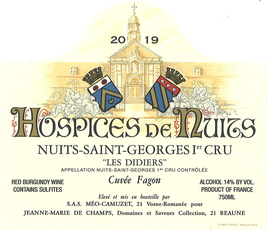
Nuits-Saint-Georges 1er Cru Hospices De Nuits Les Didiers Cuvée Fagon
The History: The origins of the Hospices de Nuit date back as early as 1270, but it was in 1692 when King Louis XIV united the many small “maladières” of Nuits into one larger hospital. In contrast to their cousin, Hospices de Beaune, the architecture of Hospices de Nuit has not made as big of a cultural impact, not has it maintained any significant archives, despite having a long and rich history of lands and vineyards being donated to the domaine.
In the past, the Hospices de Nuits sold their wine in bulk to the négoce, but all that changed in 1961 when, like Hospices de Beaune, they began their own auction. This is the ideal setup for a charity like the Hospices de Nuits as there is no need for a commercial department, there are no importers to deal with, few visitors, and the actual bottling of the wine is the responsibility of someone else.
The Vines & Vinification: Jean-Marc Moron manages the viticulture and the vinification of the Hospices de Nuits. A large seasonal team of pickers are used for the harvest, with a staff of 4 full-time employees for the rest of the year to care for the domaine’s 12.5 hectares and to manage wine production. The vines are situated within the districts of Nuits St. Georges (including Premeaux), Vosne-Romanée, and Gevrey-Chambertin. Jean-Marc Moron describes his winemaking methods as being ‘très raisonnée’ but also pragmatic; because he is responsible for delivering the income of the domaine to a charity, he does not have the luxury of being able to employ Biodynamic methods. However, he makes a point of using as few treatments on the vines as possible.
The domaine typically yields 30-35 hl/ha annually; there is a single application of herbicide out of the growing season, and then the dead material is plowed into the soil, with the additional use of pheromones throughout the growing season.
Grapes are harvested manually then triaged back at the winery. Grapes are destemmed before fermenting in stainless-steel tanks; the tanks may be cooled to 14°C if the temperature is higher, after which fermentation is allowed to take its normal course. Cooling of the tanks is possible and a system of automatic punching-down (pigeage) is employed. The wine is then fed by gravity into 100% new oak from a mix of 3 barrel-makers: Damy, Berthomieux and Sirugue. All barrels have the equivalent toasting of ‘moyen-fort’ or medium-strong. The barrels rest in an underground cellar directly beneath the winery.
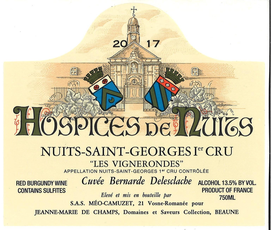
Nuits-Saint-Georges 1er Cru Hospices De Nuits Les Vignerondes Cuvée Bernarde Delesclache
Region: Côte de Nuits
Village: Nuits-Saint-Georges
Level: Premier Cru
AOC: Nuits-Saint-Georges 1er Cru
Grape variety: 100% Pinot Noir
Terroir: Les Vignerondes
Tasting: This cuvée from Les Vignesrondes (round vineyards in French) displays an intense red colour. Fruit intensity with a majority of black berries and currants. With a few years, this fine wine will evolve towards wild cherries and hints of liquorice and fresh leather.
Food Pairings: Slow-cooked lamb shank, Burgundy-style beef stew to stay local!
Domaine Thierry Hamelin – Chablis
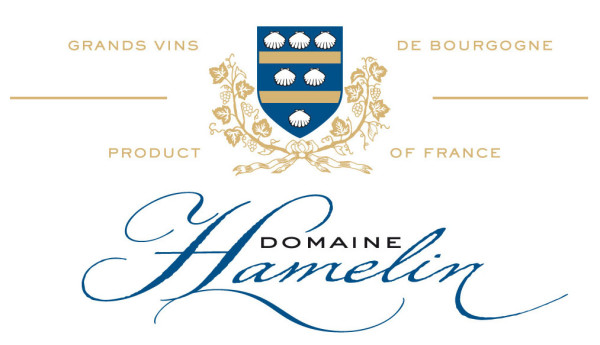
The Estate
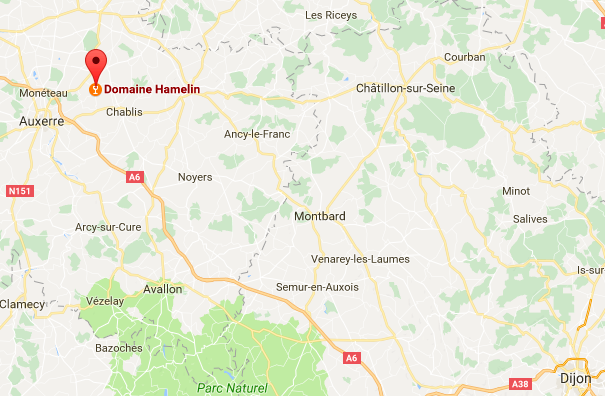
For 7 generations, the Hamelin family has been making wine – from the 1840s when Gustave Hamelin purchased 2 hectares of vines and a mule to work the land, to today where Thierry Hamelin and his son Charles cultivate over 36 hectares of vines stretched out over 3 villages. The knowledge handed down from generation to generation is a harmonious mix of old traditions and modern-day techniques. Their focus is to craft generous and elegant wines that are a pure expression of the terroir. In order to achieve this goal, a well-controlled and thermo-regulated winemaking process is essential. They bottle all of their wine in-house at the optimal moment, at which point the wine is at its most expressive.
The Terroir
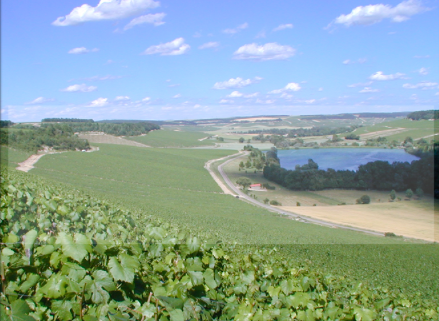 The Domaine HAMELIN harvests grapes from an area of 36.70 hectares. These vines extend over three villages: Poinchy, Beines and Lignorelles. The head office and the vat room are located at Lignorelles. The Domaine production comprises four White Burgundy wines:
The Domaine HAMELIN harvests grapes from an area of 36.70 hectares. These vines extend over three villages: Poinchy, Beines and Lignorelles. The head office and the vat room are located at Lignorelles. The Domaine production comprises four White Burgundy wines:
Petit Chablis (A.O.C.)
A total area of 9.95 hectares grown around the village of Lignorelles, on the edge of the Chablis vineyards. The soil is clay and limestone and the average annual production is 580 hl.
Chablis (A.O.C.)
A total area of 19.4 hectares, grown in the three villages mentioned above. Among these vines, in the designated Chablis area, there are still some old vines (1 ha) of 70 years and over. If the year so allows, a special wine is made from these older vines, called the Chablis “Vieilles Vignes”. The subsoil is generally limestone (Portlandian). The average annual production is 1125 hl.
Chablis 1er Cru “Beauroy” (A.O.C.)
A total area of 3.9 hectares, located on south-facing slopes, opposite the Lac de Beines. The average annual production is 210 hl.
Chablis 1er Cru “Vau-Ligneau” (A.O.C.)
A total area of 3.5 hectares, located in the village of Beines. This vine is grown in the Vallée de Vaux de Long. It extends over a steep, 200-metre slope. The average annual production is 200 hl. These subsoils include a limestone called Kimmeridgien that gives the elegance and the body of a ‘premier cru’.
-The Domaine has 10 permanent employees.
-The grapes are harvested manually (10 %) and mechanically.
-The total annual harvest of the Domaine is 2100 hl.
-The wines are aged in tanks before being bottled.
-80 % of the harvest is bottled (around 270,000 bottles).
As well as having a single Chardonnay grape variety, our vineyards are planted on soil that is 150 million years old, from the Jurrasic, or to be exact, the Kimméridgien, era. During this period, Burgundy was under the sea, which has left us a number of remains to be found in the rock, such as small oysters and ammonites. The fundamental characteristic of Chablis depends on its soil, or ‘terroir’, that gives it the typical minerality that cannot be found anywhere else. The dry, clear, aromatic, lively and light nature of Chablis, which no other Chardonnay wine can match, is due to the link uniting the grape variety to its soil.
Hamelin's expertise
Even though the nature of the soil is the key element of the 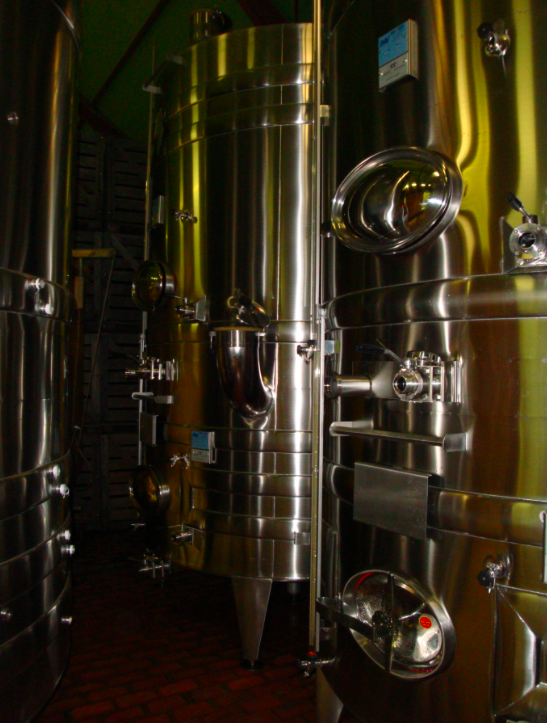 ‘terroir’, many other natural factors influence the quality, typicity and expression of a wine, such as the direction which the vine plots are facing, the altitude, the depth, the climatic conditions of the year and the micro climate. Finally, the role of man is a determining factor in wine production; in the vineyard, as regards the choice and implementation of growing methods – from pruning to harvesting – and in the cellar, as regards the wine-making process and aging.
‘terroir’, many other natural factors influence the quality, typicity and expression of a wine, such as the direction which the vine plots are facing, the altitude, the depth, the climatic conditions of the year and the micro climate. Finally, the role of man is a determining factor in wine production; in the vineyard, as regards the choice and implementation of growing methods – from pruning to harvesting – and in the cellar, as regards the wine-making process and aging.
For this reason, we pay close attention to our vines. We work in a way that respects the environment, using integrated pest control. This means that we use as few treatment products as possible and we choose those that are least harmful to the neighbouring fauna. We now give a higher priority to working the soil.
For a number of years, we have been testing cover planting and today, a third of our vineyard is no longer grass-free. We use inter-vine hoes and ploughs to control vegetation. We have noticed that these vines have a higher biomass and more varied fauna. As regards the wine-making process, the must runs by gravity from the presses to the vats, ensuring ideal quality. Our vat room is thermo-regulated, giving us total control over the vinification and enabling us to age the wine in the best possible conditions. We carry out the bottling ourselves at the optimal moment, during which the wine is at its most expressive.

Petit Chablis
Production Area: 9.95 hectares grown around the village of Lignorelles, on the edge of the Chablis vineyards
Soil: Clay and limestone
Annual Production: 580 hl
Grape Varieties: 100% Chardonnay
Vinification: Traditional vinification in thermo regulated vats. Maturation in vats can last more than 9 months and then is followed by a collage and filtration.
Tasting Notes: Color: vivid, light gold yellow, with a slight hint of green. Nose: expressive, white flowers tending towards iodine. Palate: rounded with a touch of minerality, soft with good length of finish
Serving Suggestion: It can be drunk at any time of the day, particularly as an aperitif or with lunch. It is a perfect match for ‘charcuterie’ pâtés and deli meats, as well as a number of cooked dishes. Serve at between 10 and 12°C.
Cellaring Potential: Will keep 2 to 5 years.

Chablis
Production Area: 19.4 hectares in the Lignorelles and Beines districts
Soil: The subsoil is generally chalky limestone (Portlandian)
Annual Production: 1,125 hl
Grape Varieties: 100% Chardonnay
Vinification: Traditional vinification in thermo-regulated vats. Maturation in vats can last more than 9 months and then is followed by a collage and filtration.
Tasting Notes: Vivid yellow color with a hint of green. The bouquet is discreet with a touch of hawthorn blossom and freshness. On the palate, it is round, fresh, and mineral. Good length and a powerful finish.
Serving Suggestion: The Chablis is served chilled (12-14°C) with oysters, seafood, charcuterie pâtés and deli meats, pork dishes or snails. It also goes well with goats’ cheeses and gruyere cheese.
Cellaring Potential: Will keep 5 to 8 years.

Chablis Vieilles Vignes
Average Age of the Vines: 70+ years old
Soil: Largely limestone (Portlandian) soil.
Grape Varieties: 100% Chardonnay
Vinification: Traditional vinification in thermo-regulated vats. Maturation in vats can last more than 9 months and then is followed by a collage and filtration.
Tasting Notes: Color: golden yellow with a slight hint of green, vivid. Nose: iodized and floral (white springtime wild flowers) Palate: round and mineral with a touch of spice, or even pepper. It has a good, fully unctuous finish.
Serving Suggestion: The Chablis Vieilles Vignes can be served with a 4 o’clock tea and biscuits, as an aperitif or with the meal, accompanying subtle dishes, such as langoustine or fish quenelles.

Chablis 1er Cru Beauroy
Production Area: 3.9 hectares, located on south-facing slopes, opposite the Lac de Beines
Annual Production: 210 hl
The Vines: This wine is produced from vines located on very steep south-facing slopes (30-40% incline), that were planted between 1980 and 1982. They extend from the bottom of the valley to the top of the slopes.
Soil: Kimmeridgien subsoil
Grape Varieties: 100% Chardonnay
Vinification: Traditional vinification in thermo-regulated vats. This wine is aged for 12-18 months in stainless steel vats before bottling.
Tasting Notes: Vivid golden color with a hint of green. Fragrant with notes of white flowers such as acacia and hawthorn. Round, expressive, and unctuous on the palate with a fine minerality. Powerful and rich.
Serving Suggestion: This wine may be drunk quite young as it has plenty of richness and fruit, but its zesty acidity make it a good choice for wine collectors interested in older and exceptional wines. The Chablis 1er Cru Beauroy pairs perfectly with lighter fishes and seafood as well as poultry and various cheeses.

Chablis 1er Cru Vau Ligneau
Terroir: The Chablis 1er Cru Vau Ligneau is located in the Beine district. The vines grow in the Vaux de Long valley and extend over a steep slope (30-50% gradient) about 200 meters long. At the top of the valley, the Kimmeridgian subsoil rubs shoulders with the Portlandian soils.
Production Area: 3.5 hectares
First Planting: 1978 and 1980
Tasting Notes: Pale yellow color with hints of green. The nose is powerful with elegant mineral and floral notes. On the palate, it is complex, round, and rich with a beautiful structure and finish.
Serving Suggestion: Serve at 12-14°C, paired with fish, veal, etc.
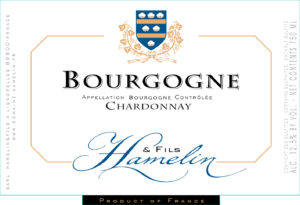
Bourgogne Chardonnay
Soil: Clay-limestone
Grape Varieties: 100% Chardonnay
Average Age of the Vines: 35 years old
Average Yield: 60 hl/ha
Vinification: The grapes are harvested at peak ripeness. After sorting and pressing, 100% of vinification takes place in stainless-steel vats.
Tasting Notes: Light golden color. On the nose, this wine has delicate notes of orange marmalade and white flowers, supplemented by a light minerality. Soft and round on the palate with a juicy acidity; notes of golden delicious apple, apricot, and citrus. Nice tension on the finish.
Food Pairings: It pairs perfectly with aged cheeses, shellfish, and cold cuts.
Alcohol: 12.5%
Serving Suggestion: 11-12°C
Jane Eyre

The Estate
Originally a hairdresser for many years, and hailing from southeastern Australia, Jane Eyre-Renard decided to immerse herself in the world of winemaking after developing a passion for it while working for a wine merchant in Melbourne. She eventually left her native land in the pursuit of educating herself more on the subject. She studied oenology and traveled to New Zealand and Germany to make wine, all while going back and forth to Burgundy, before finally settling in Beaune in 2004. She trained with Chevrot, Thierry Matrot, and Dominique Lafon, after which she joined Chris Newman of Domaine Newman in 2006 whom she still assists today. Gifted with a barrel from Newman, a €6,000 loan from a friend, and encouragement from Benjamin Leroux (renowned biodynamic winemaker from Beaune), Eyre began her own winemaking operation in 2011, purchasing grapes from Savigny, Gevrey, Aloxe-Corton (beginning in 2013), and a Grand Cru Corton-Renardes.
Ms. Eyre’s prefers the approach of minimal intervention when it comes to winemaking, and her style is elegant – fine, lightly oaked wines, with delicate fruit on the palate.
In 2021, Jane Eyre-Renard became the first woman (and first Australian) to win the coveted ‘Negociant of the Year’ award from La Revue du Vin de France. This prestigious title recognizes the talent of independent winemakers who purchase grapes to make their own wine.
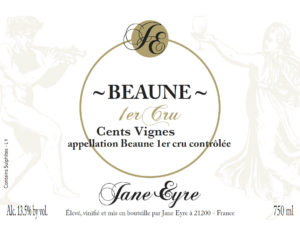
Beaune 1er Cru Cents Vignes
Grape Variety: 100% Pinot Noir
Harvest: The grapes are hand picked into 12 kg cases, then sorted at the winery using a vibrating sorting table. Eyre focuses on purchasing the best fruit she can and sorting it thoroughly so that nothing will need to be forced during winemaking.
Vinification: Minimal sulfur prior to fermentation (levels depend on the vintage), and minimal intervention during the vinification process.
Alcohol: 13.5%
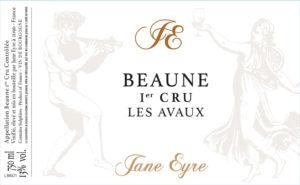
Beaune 1er Cru Les Avaux
Overview: The domaine where Jane Eyre sourced the fruit for the Beaune 1er Cru Cent Vignes was sold in 2020 and the new owner decided to keep all the fruit, but she was delighted to have found another Beaune 1er Cru to replace it – Les Avaux.
Location: The Avaux vineyard is located on the Pommard side of Beaune. Domaine Newman (where Jane Eyre worked for 13 years) owned a parcel of Clos des Avaux so she knows the area well. The wine was always one of her favorites at the domaine, and she is very pleased to find many similar characters in the wine made from this new parcel. The resulting wine from this plot is a finer wine than the Cent Vignes.
Grape Variety: 100% Pinot Noir
Aging: Matured in 3 x 228 and 1 x 350 liter barrels, the latter one year old.
Alcohol: 13.0%
Production: 4.5 barrels
Winemaker Tasting Notes: “The nose is really perfumed; this is a fine, discreet Beaune with nonetheless a fair amount of fruit weight beneath.” JM
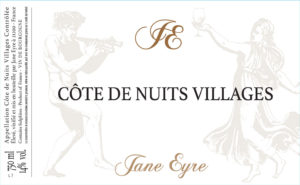
Côte de Nuits-Villages
Plot: This wine is a blend of 2 plots located halfway up the hill in Comblanchien. Ms. Eyre has been producing wine from these plots since 2014.
Grape Variety: 100% Pinot Noir
Harvest: The grapes are hand picked into 12 kg cases, then sorted at the winery using a vibrating sorting table. Eyre focuses on purchasing the best fruit she can and sorting it thoroughly so that nothing will need to be forced during winemaking.
Vinification: Minimal sulfur prior to fermentation (levels depend on the vintage), and minimal intervention during the vinification process.
Alcohol: 14%
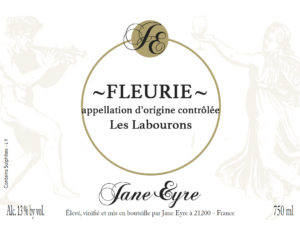
Fleurie Les Labourons
Vines: 80-year-old vines, mass selection on the renowned Labourons area in Fleurie.
Grape Variety: Gamay
Harvest: The grapes are hand picked into 12 kg cases, then sorted at the winery using a vibrating sorting table. Eyre focuses on purchasing the best fruit she can and sorting it thoroughly so that nothing will need to be forced during winemaking.
Vinification: Minimal sulfur prior to fermentation (levels depend on the vintage), and minimal intervention during the vinification process.
Aging: Aged in 500-liter used barrels, 3 weeks on the skins.
Alcohol: 13%
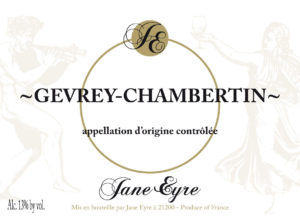
Gevrey-Chambertin
Vines: This wine is produced from 35-55 year old vines planted on two hillside parcels: Combe du Dessus (in front of the Château de Chambertin), and En Champs (farther up the slope in front of the premier cru Champeaux).
Grape Variety: 100% Pinot Noir
Harvest: The grapes are hand picked into 12 kg cases, then sorted at the winery using a vibrating sorting table. Eyre focuses on purchasing the best fruit she can and sorting it thoroughly so that nothing will need to be forced during winemaking.
Vinification: Minimal sulfur prior to fermentation (levels depend on the vintage), and minimal intervention during the vinification process.
Alcohol: 13%
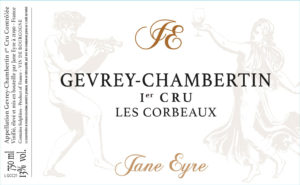
Gevrey-Chambertin 1er Cru Les Corbeaux
Location: The grower is the same as for the Gevrey-Chambertin village, and as he always likes to point out, his village vineyards are situated opposite Premier Cru vineyards. Les Corbeaux sits right next to Mazis Chambertin Grand Cru on the south side of the village.
Grape Variety: 100% Pinot Noir
Vinification: 20% whole bunch vinification. The wine was racked once to tank and was bottled on the 16th November.
Aging: Matured in oak barrels. This is the only wine in 2021 that has any new oak – approximately 30%.
Production: 3.5 barrels
Winemaker Tasting Notes: “The power of the terroir of Gevrey is found in flavors of licorice and baked cherries. The wine is still restrained and needs time to open up. The palate is quite tight with hints of chocolate and toasted oak. The elegance of this wine belies its complexity and ability to age. These are characteristics I have always found in Domaine Newman’s Mazis Chambertin (my old day job).”
Alcohol: 13.0%
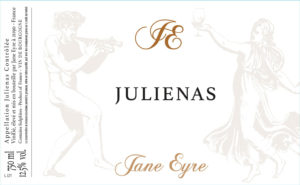
Julienas
Overview: New to the range. The fruit comes from 2 parcels of old vines that are farmed organically.
First Vintage: 2021
Grape Variety: Gamay
Vinification: Given the cool growing season, Ms. Eyre decided to destem most of the fruit. She used 10% whole bunch to provide some more texture to what is traditionally one of the lighter Beaujolais crus.
Aging: Most of this wine was aged in stainless steel tank with 10% going into older barrels. Bottling in mid November.
Production: 5 barrels
Serving Suggestion: The wine is intended to be drunk young, and many people will find a slight chill to this wine helps to highlight the freshness and delicacy.
Alcohol: 12.5%
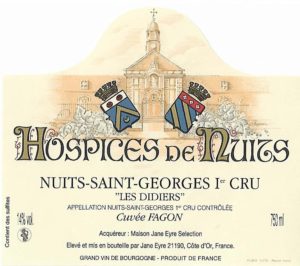
Nuits-Saint-Georges 1er Cru Hospices De Nuits Les Didiers Cuvée Fagon
Note: Jane Eyre purchased 2 barrels at the Hospice Auction in March 2021. It is the first time she bought anything from this auction.
Location: This is a monopole owned by the Hospice. Exceptionally positioned between Les Fôrets and Les Saint Georges 1er Cru vineyards. They make 3 separate cuvées.
Age of the Vines: Fagon is made from 70 year old vines, the oldest part of the vineyard.
Grape Variety: 100% Pinot Noir
Vinification: The grapes are 100% destemmed. The wine is moved into older oak to finish its barrel aging.
Tasting Notes: The wine has dark fruit notes with spice and concentration but isn’t a heavy wine given the warm conditions of the growing season.
Cellaring: This is definitely a wine to leave in the cellar for at least 5-15 years.
Alcohol: 14%
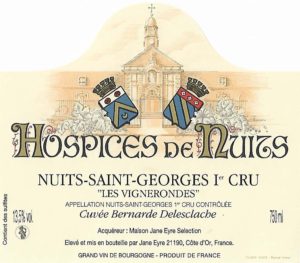
Nuits-Saint-Georges 1er Cru Hospices De Nuits Les Vignerondes Cuvée Bernarde Delesclache
Note: Jane Eyre purchased 2 barrels at the Hospice Auction in March 2021. It is the first time she bought anything from this auction.
Location: Situated near the more famous vineyard of Murgers.
Grape Variety: 100% Pinot Noir
Vinificaton: As with the Didiers, this wine was transferred from new oak into an older barrel.
Tasting Notes: This is a fresh wine with dark fruit and forest floor notes. A dense core of fruit and long tannins that are firm but silky.
A bit less showy in its youth than the Didiers, but will age very well.
Cellaring: Keep 8-15 years.
Alcohol: 13.5%
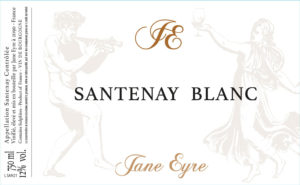
Santenay Blanc
Terroir: The Santenay Blanc is from a single vineyard situated above the village. The altitude of the vineyard helps keep freshness and acidity in the fruit which is a great advantage in the hotter years.
First Vintage: 2021
Exposition: Southeast facing
Soil: Limestone, gravel
Grape Variety: 100% Chardonnay
Harvest: The fruit is handpicked and sorted.
Vinification: Whole bunch pressed. The juice is settled overnight to remove the heavy sediment and then transferred to barrel for fermentation.
Aging: The wine was racked once to tank and then fined and filtered before bottling at the end of August 2022. In 2021, there was roughly 6 barrel of varying sizes. One new barrel.
Production: About 6 barrels
Alcohol: 12.0%
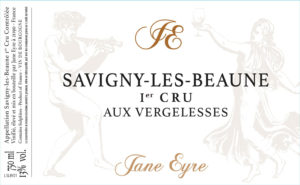
Savigny-les-Beaune 1er Cru Aux Vergelesses
Location: Aux Vergelesses is one of the best Premier Crus in Savigny-les-Beaune. The vineyard is located in the upper middle section on a steep, well-draining, eastern-facing slope that faces Mont Blanc.
Soil: Clay-limestone
Grape Variety: 100% Pinot Noir
Average Age of the Vines: 25-50 years old
Vinification: 100% de-stemmed and no new oak. Racked and assembled into tank after harvest and bottled the 16th of November.
Tasting Notes: This is the cuvée Ms. Eyre started her negociant with in 2011. The wine is always a mix of delicate fruit aromas with spicy undertones and a brambly edge, with fine but firm tannins on the finish. Relatively approachable now, it will gain complexity with some time in the cellar.
Production: 4 barrels
Alcohol: 13.0%
***JURA***
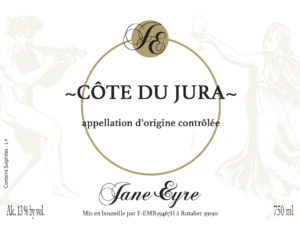
Côtes Du Jura Chardonnay
Vines: After researching for 5 years in the Jura, Ms. Eyre selected a parcel of Chardonnay in the heart of the Arbois Vineyard. The vines are 60 years old and are grown biodynamically.
Grape Variety: 100% Chardonnay
Harvest: The grapes are hand picked into 12 kg cases, then sorted at the winery using a vibrating sorting table. Eyre focuses on purchasing the best fruit she can and sorting it thoroughly so that nothing will need to be forced during winemaking.
Vinification: The Chardonnay is vinified and aged in both oak barrel (500 litres) and stainless-steel tank for 18 months. Sulfur is not used, making it the most natural wine of her offering.
Alcohol: 12.5%
Les Champs de L’Abbaye (Certified Organic)

The Estate
A 6-hectare family domaine spread out over various appellations of the Cote Chalonnaise, Les Champs de l’Abbaye was established in 1997 and takes its name from the first parcel that owners Alain and Isabelle Hasard ever bought. Formerly office-workers living in Paris, they decided to start a new career in winemaking and purchased vineyards in the Bourgogne Côtes du Couchois. Years later, they acquired a property in the Côte Chalonnaise, and today they craft wines sourced from such respected Burgundian appellations as Mercurey and Rully.
The estate has been certified organic since 1999 and is also certified biodynamic by Demeter. In the words of Alain and Isabelle, “At the cellar, we use only natural yeasts, and follow the profile specific to each vintage and each terroirs, thus avoiding additives or manipulations of any kinds. The wines are bottled without fining or filtration.” Everything is naturally grown on their estate, hand-harvested, and fermented using indigenous yeasts for spontaneous fermentation. They use no additives and no fining or filtering.
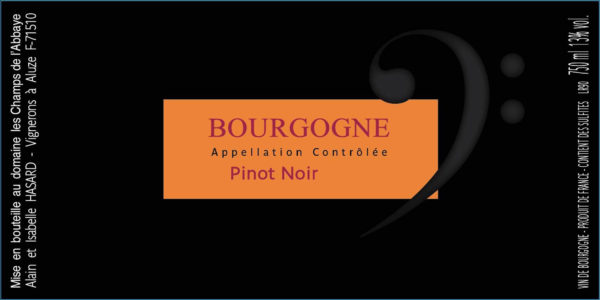
Bourgogne Pinot Noir
Location: This is a blend from 2 different plots situated in the town of Aluze (between Rully and Mercurey).
Average Age of the Vines: 40-50 years old.
Soil: Very pretty limestone or marl-limestone soils from the Jurassic period.
Yield: 45 hl/ha
Vinification: 20% destemming. Pressing before the finish of alcoholic fermentation. Vatting for 12 days.
Aging: 8 months, partly in stainless steel vats, partly in barrels.
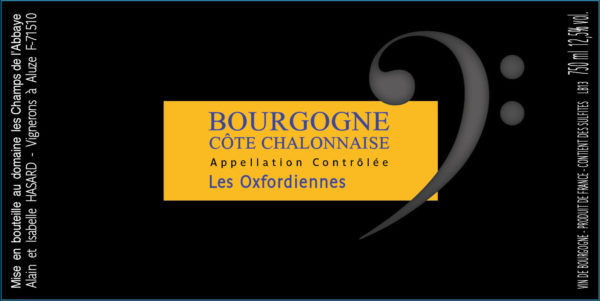
Bourgogne Côte Chalonnaise Les Oxfordiennes Blanc
Vineyard Plot: This wine is produced from 2 plots, one planted in 1995 and the other in 2019, in the lieu-dit “Les Claveaux”. The vines are planted at high density and over a wide selection of qualitative Chardonnays.
Soil: White marl terroir, called “Oxfordiennes”.
Grape Variety: 100% Chardonnay
Alcohol: 12.5%
Tasting Notes: Supple, very expressive wine, with a lemony finish.
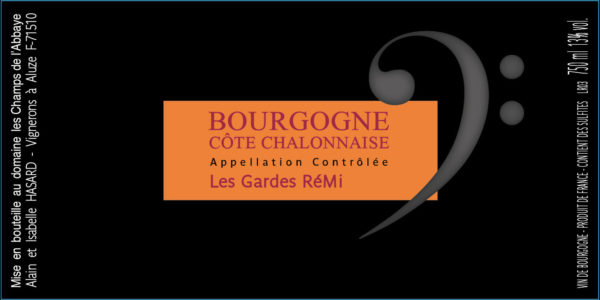
Bourgogne Côte Chalonnaise Les Gardes Rémi
Overview: Les Gardes RéMi is a new wine for Les Champs de l’Abbaye, coming from a plot of Pinot Noir vines at least 70 years old in the Côte Chalonnaise which was taken over by Alain Hazard in 2019.
Appellation: Côte Chalonnaise
First Planting: 1954
Grape Variety: 100% Pinot Noir
Vinification: Part of the harvested grapes were not destemmed and instead pressed entirely with the stalks. No use of sulfur dioxide in fermentation which is started with indigenous yeasts. Cold maceration at 10°C for a period of 5 days.
Aging: 12 months in barrels (20% new wood).
Alcohol: 13%
Tasting Notes: Lots of freshness and aromatic expression. Notes of red fruit and spices, with a broad palate and a fairly structured body while showing strong acidity and refined tannins.
Cellaring: 5 years from vintage.
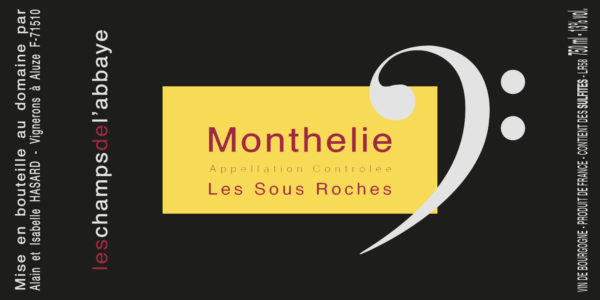
Monthélie Blanc Les Sous Roches
Production Area: 5 hectares
Soil: Oxford white marl. The extremely draining nature of the soil, combined with the repeated climatic incidents that this area has experienced for several years has made the production of this wine long and complicated.
Exposition: East. The vines are planted on a very steep slope beneath a rock bank (“Les Sous Roches”). This dominant position offers a magnificent view of the vineyards of Monthélie, Meursault, and the Bresse plain.
First Planting: In 2012 from massive selections of Chardonnays and qualitative clones.
Plant Density: 11,000 vines/ha
Harvest: Very small first harvest in 2017 (10 hl / ha), 6 years after planting.
Vinification: Pneumatic pressing of the whole harvest. Natural yeasts. Alcoholic (11 months) and malolactic fermentation in barrels (30% new). Light fining and filtration on pure cellulose plates.
Tasting Notes: Pure with little sulfur. Dry, clear, & precise character. Subtle fruit, prominent mineral flavors, and firm acidity.
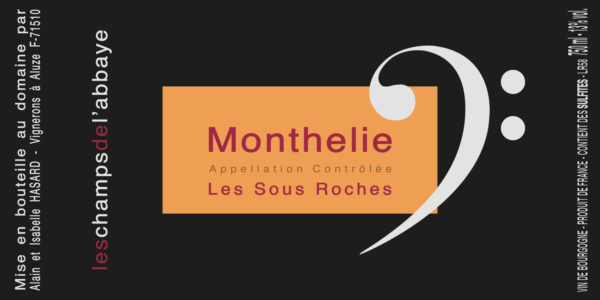
Monthélie Rouge Les Sous Roches
Production Area: 5 hectares
Soil: Light, gravelly soil composed of limestone
Exposition: To the east, steeply sloped
Average Age of the Vines: 50 years old
Yield: 25 hl/ha
Vinification: 30% vinified in whole bunches. Indigenous yeasts. Fermentation lasts 12 days, with devatting before the end of alcoholic fermentation.
Aging: In barrels (30% new wood) for 12 months and 1 month in assembly tanks.
Tasting Notes: The nose offers intense aromas of raspberry and prune. Fruity on the palate with mellow oak and consistent but pleasant tannins which structure the wine without harshness and allow it to age well.
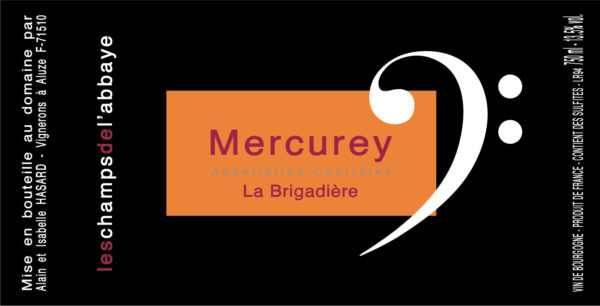
Mercurey Rouge La Brigadière
Location: This plot is located at the upper limit of the 1st growths.
Soil: Shallow, light-brown soil with scree of white Nantoux limestone, on a subsoil of white marl.
Exposition: Southwest
Surface Area: 0.5 hectares
Average Age of the Vines: 40-45 years old
Yield: 40 hl/ha
Vinification: 20% whole harvest – natural yeasts. Vatting time – 10 days.
Aging: 11 months in barrels (of which a third is in new barrels) and one month in an assembly tank.
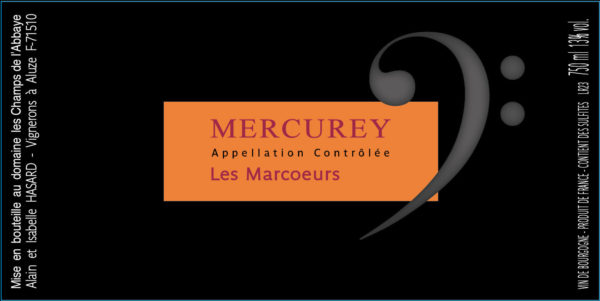
Mercurey Rouge Les Marcoeurs
Vineyard Plot: Situated under the 1er Cru, Clos des Miglands.
Soil: Limestone soil with shell debris, ferruginous red soil.
Exposition: East, southeast
Production Area: 0.78 hectares
Grape Variety: 100% Pinot Noir
Average Age of the Vines: 15-40 years old
Yield: 40 hl/ha
Vinification: 20% destemming. Indigenous yeasts. 12 days of vatting with 5 days pre-fermentation natural maceration.
Aging: 11 months in barrels (30% new wood)
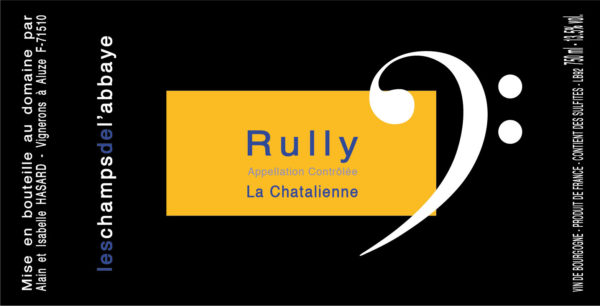
Rully Blanc La Chatalienne
Location: Located just beneath the Cailloux plot
Soil: The limestone slab sinks quickly to give way to a thick layer of fine, red-colored clays.
Exposition: East – southeast, very ventilated.
Average Age of the Vines: 35- 40 years old
Vinification: Pneumatic pressing of the entire harvest. Natural yeasts used. Alcoholic fermentation for 11 months and malolactic fermentation in barrels (30% new wood). Light fining and filtration on a pure cellulose plate.
Yield: 30 hl/ha
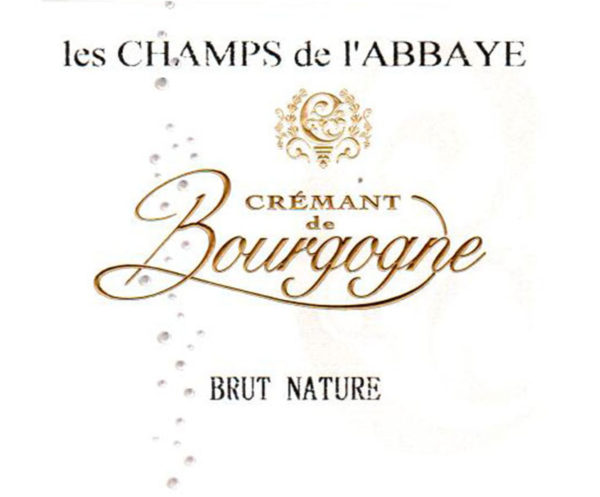
Crémant de Bourgogne Brut Nature
Grape Blend: 2/3 Pinot Noir, 1/3 Chardonnay
Yield: 15 hl/ha
Vinification: Grapes harvested with good maturity for a base wine (11.8% vol) and with the typical acidity of the vintage. Hasard only keeps the first press for this wine. No sugar is added during disgorging.
Tasting Notes: Nose of ripe fruit, typical for Pinot. Fresh and tense mouth.
Food Pairings: This Crémant is perfect as an aperitif and when served with oysters.
Dosage: 0 g/l
Alcohol: 12.5%





